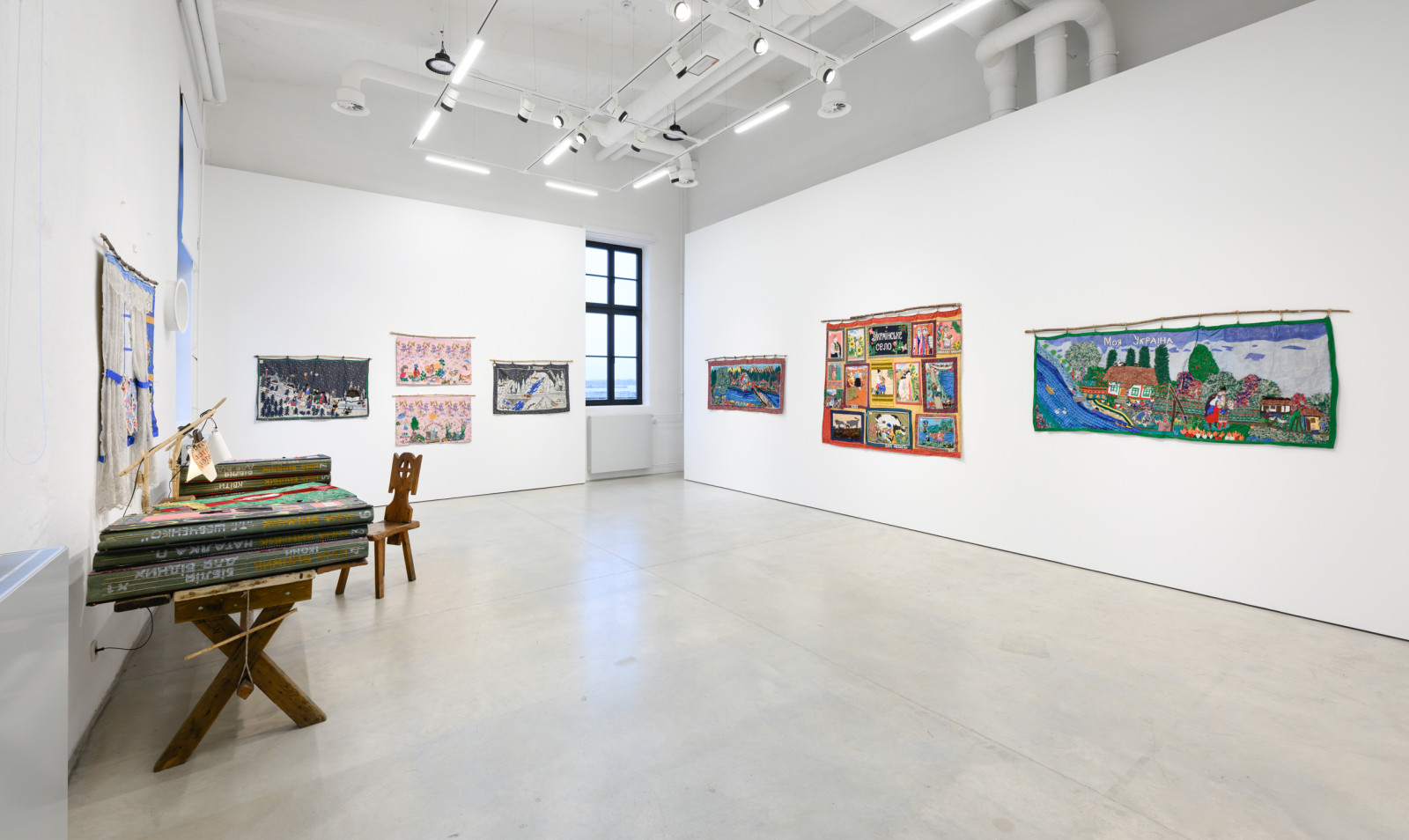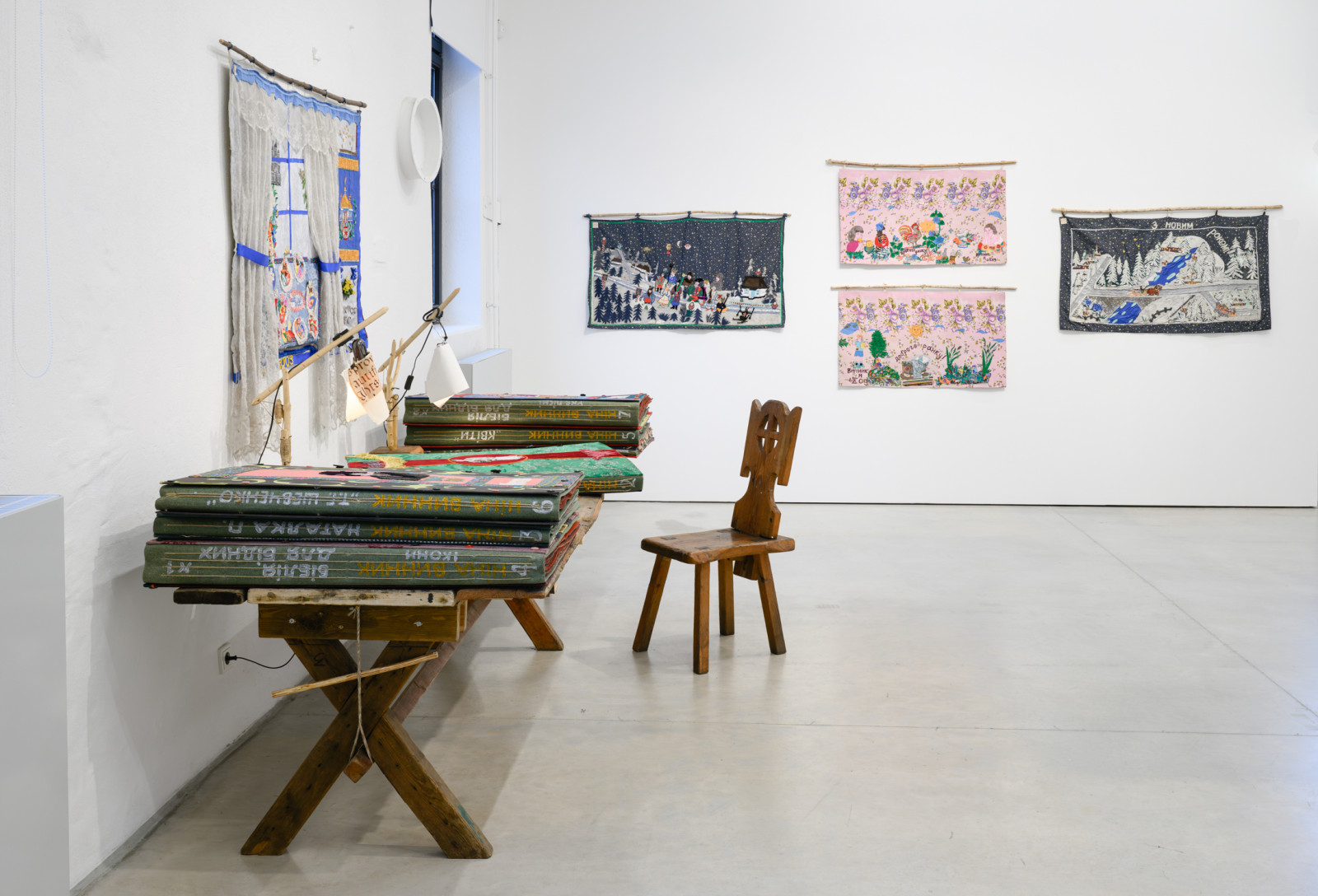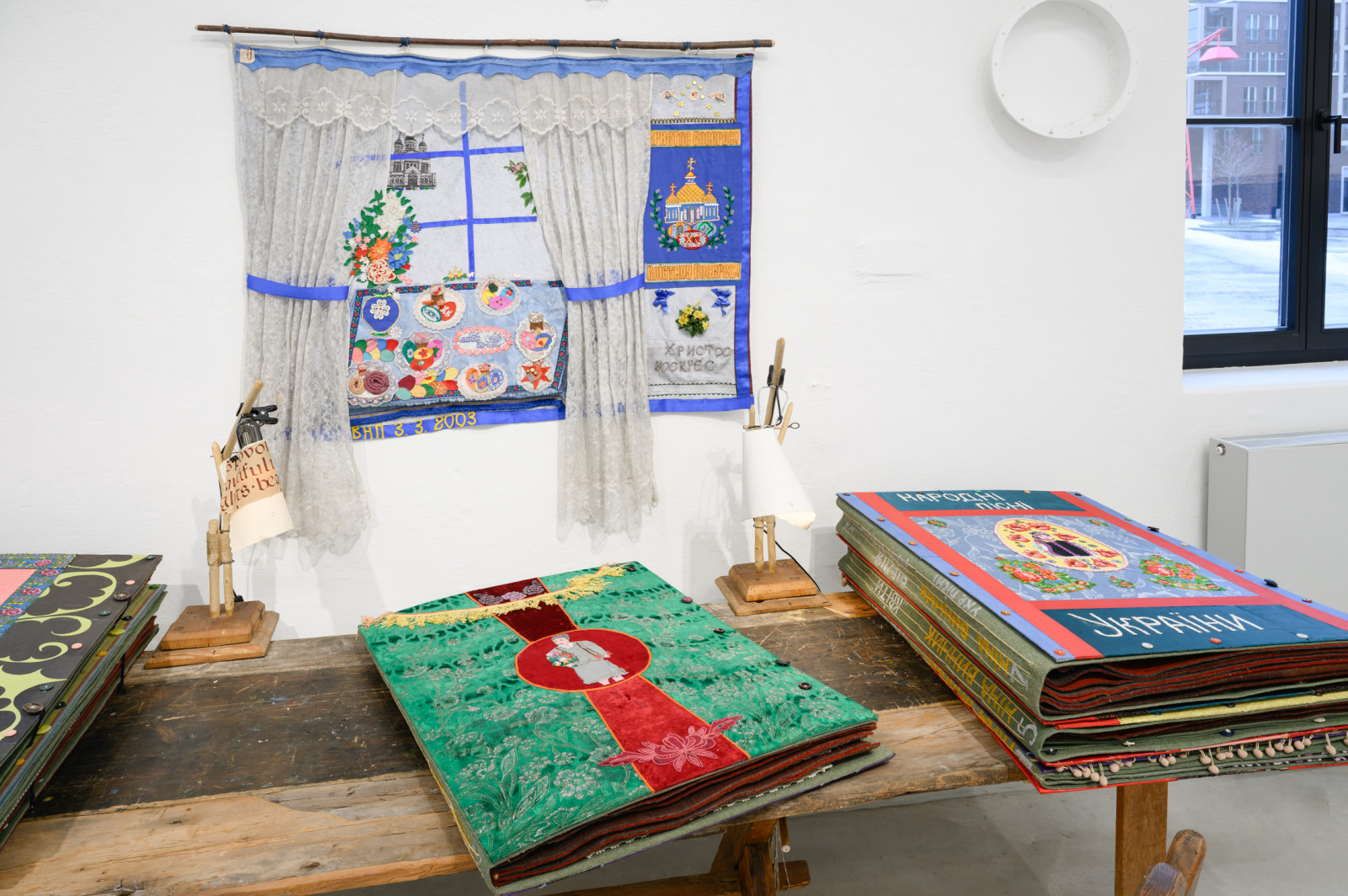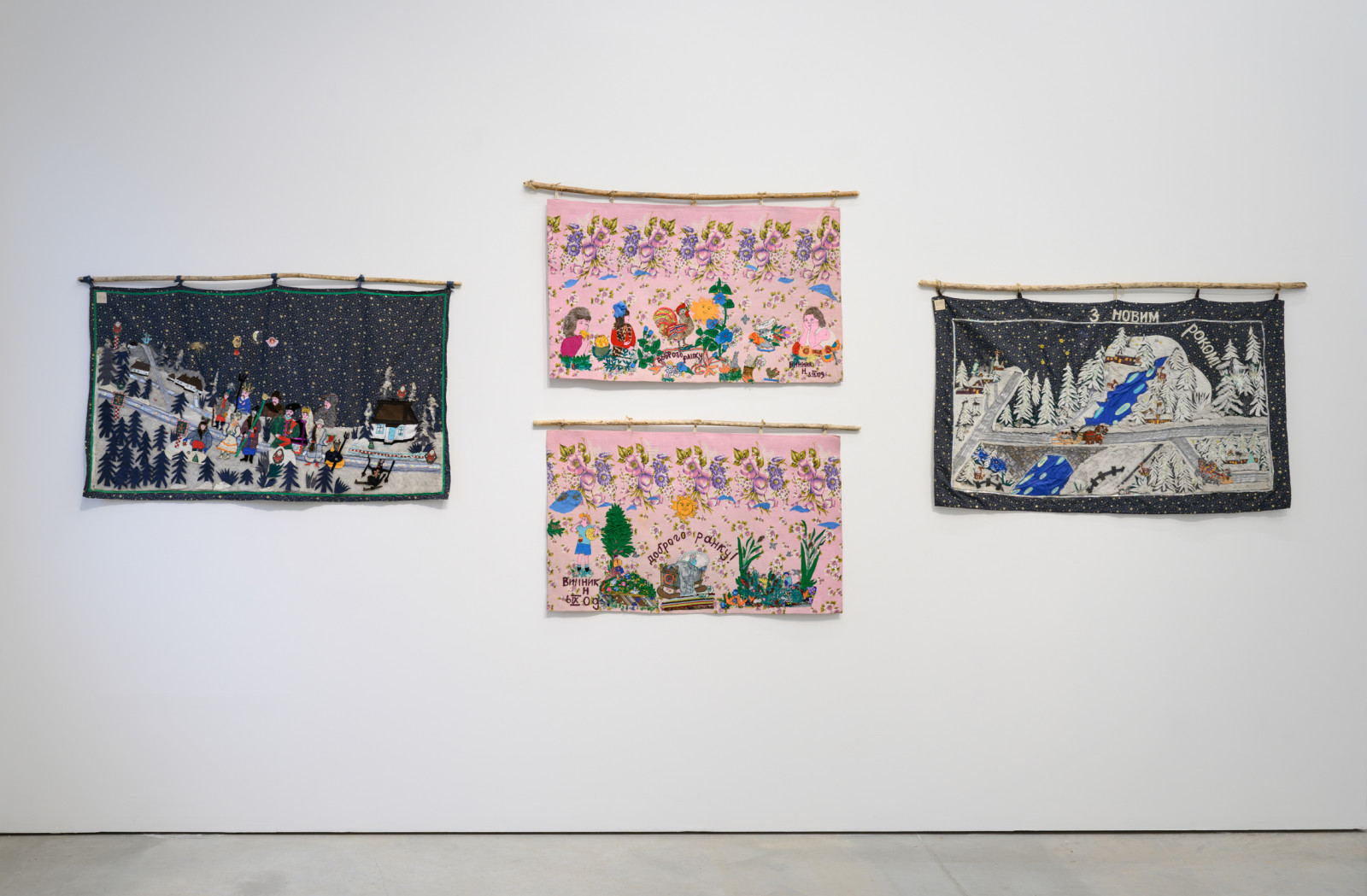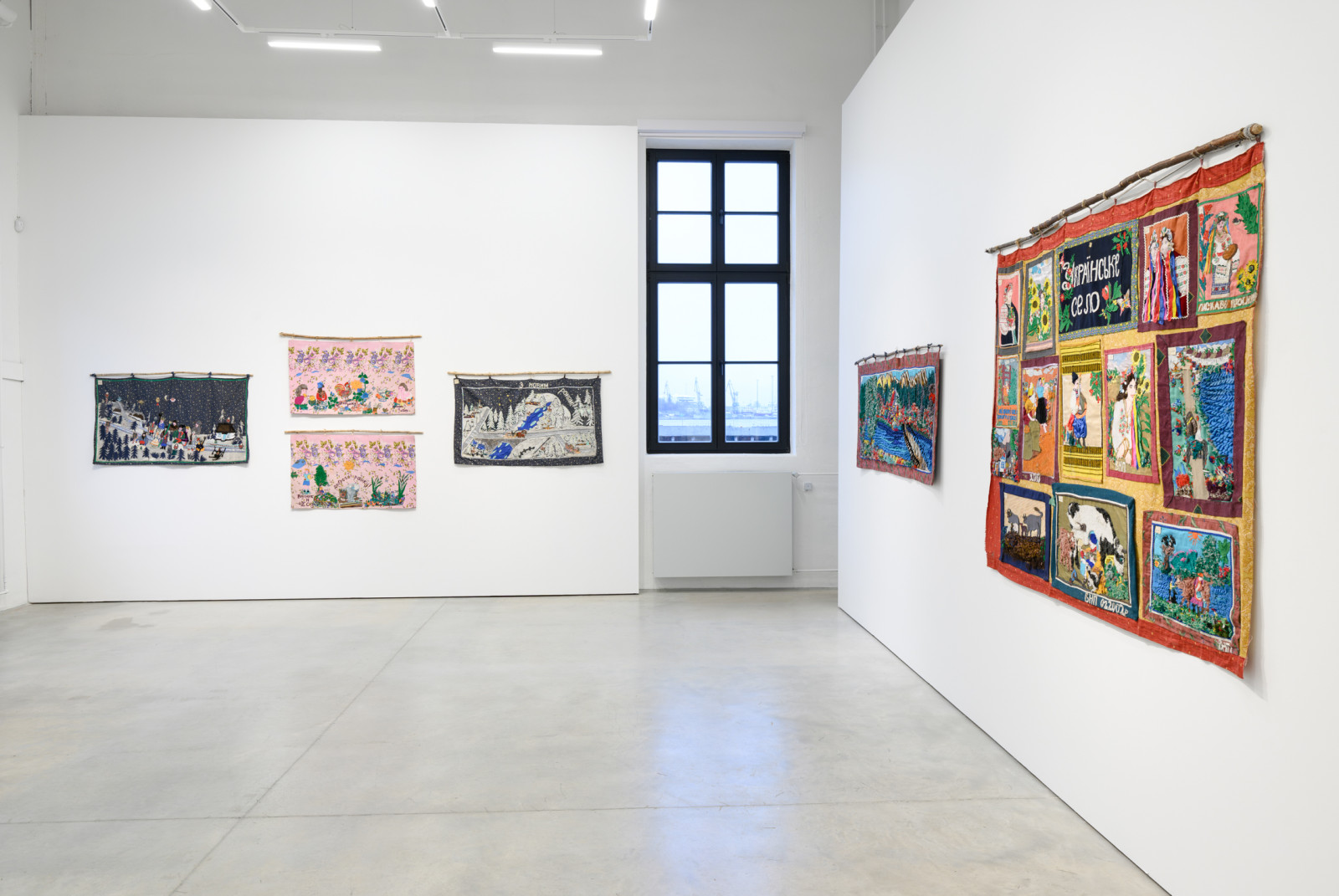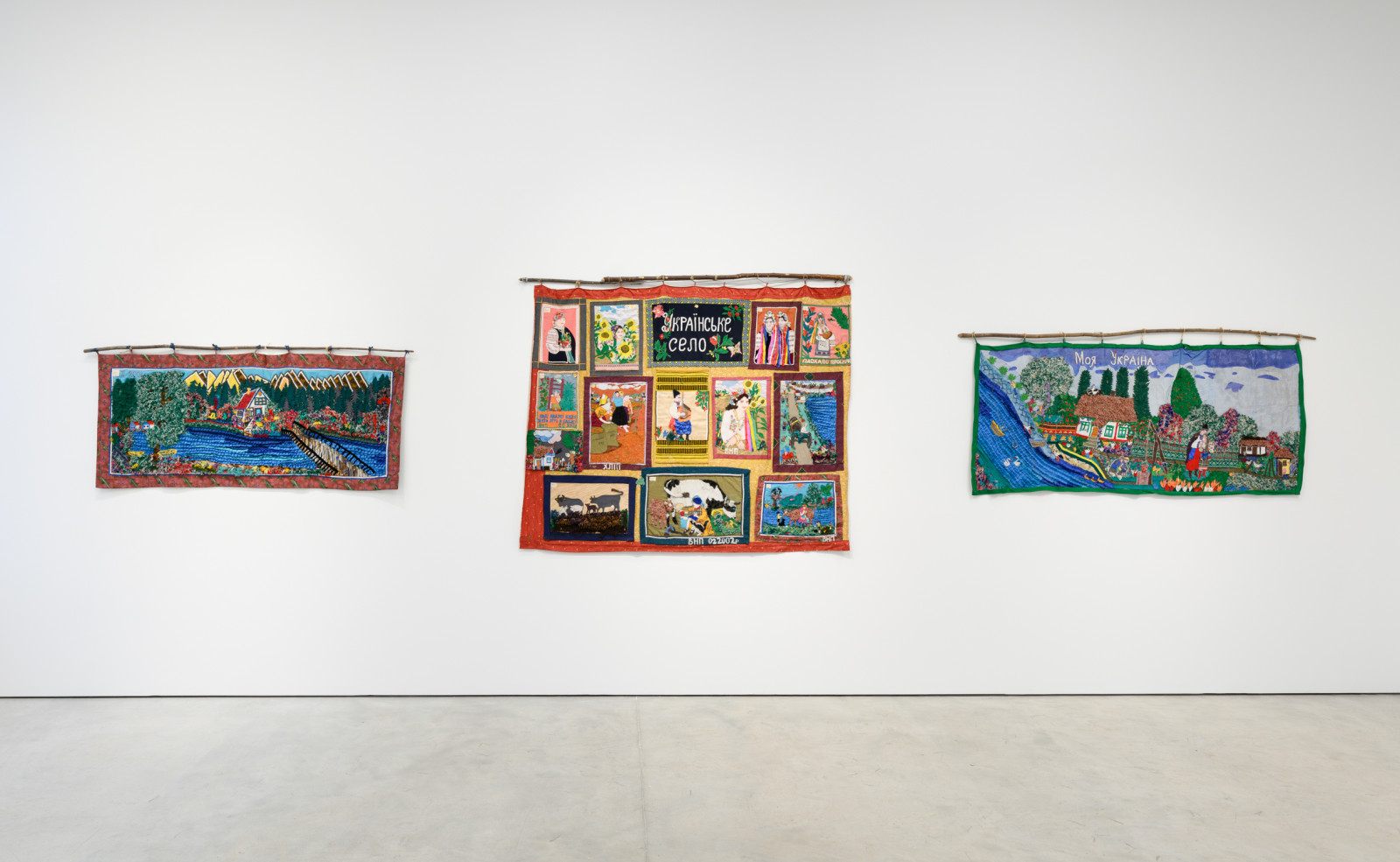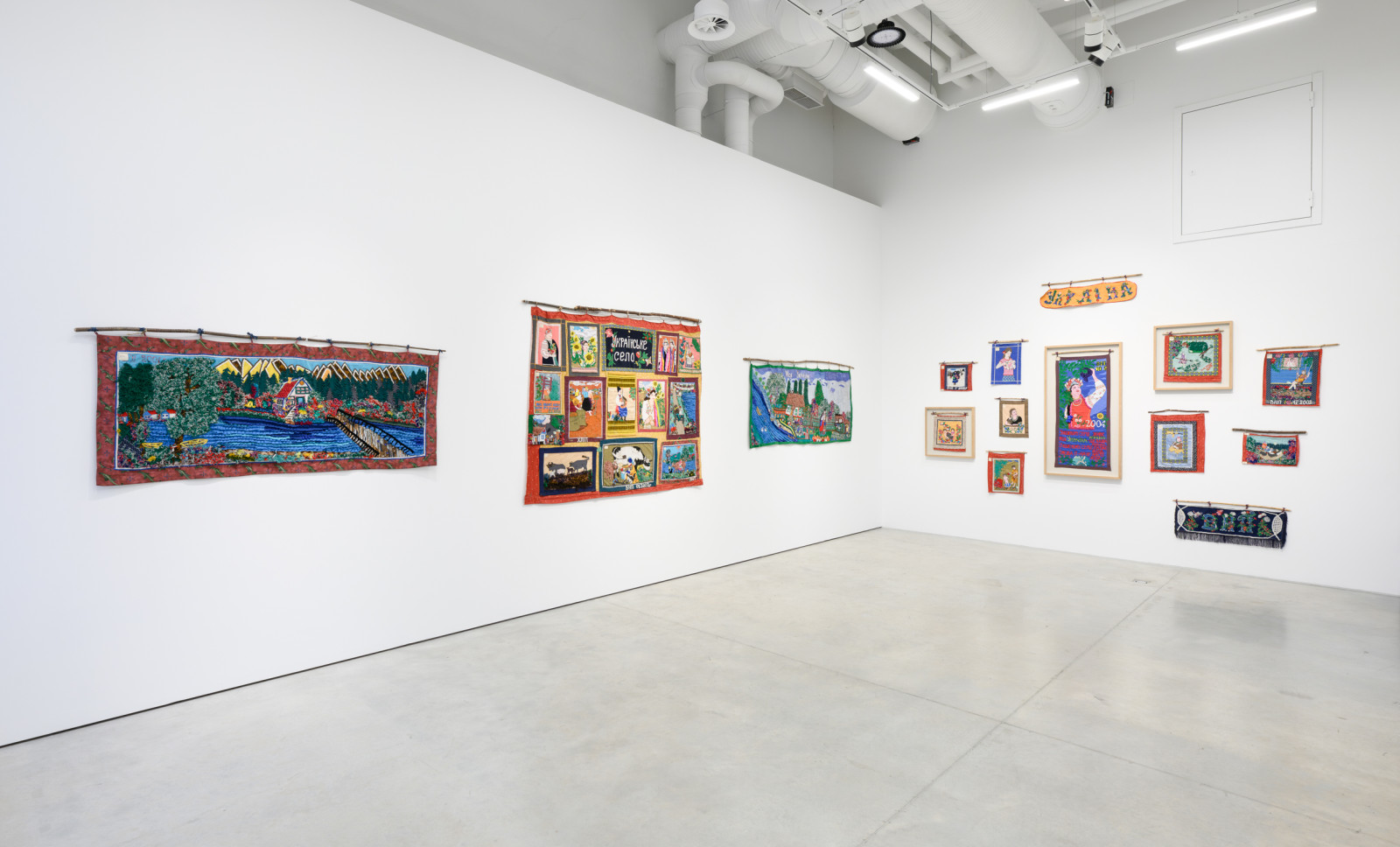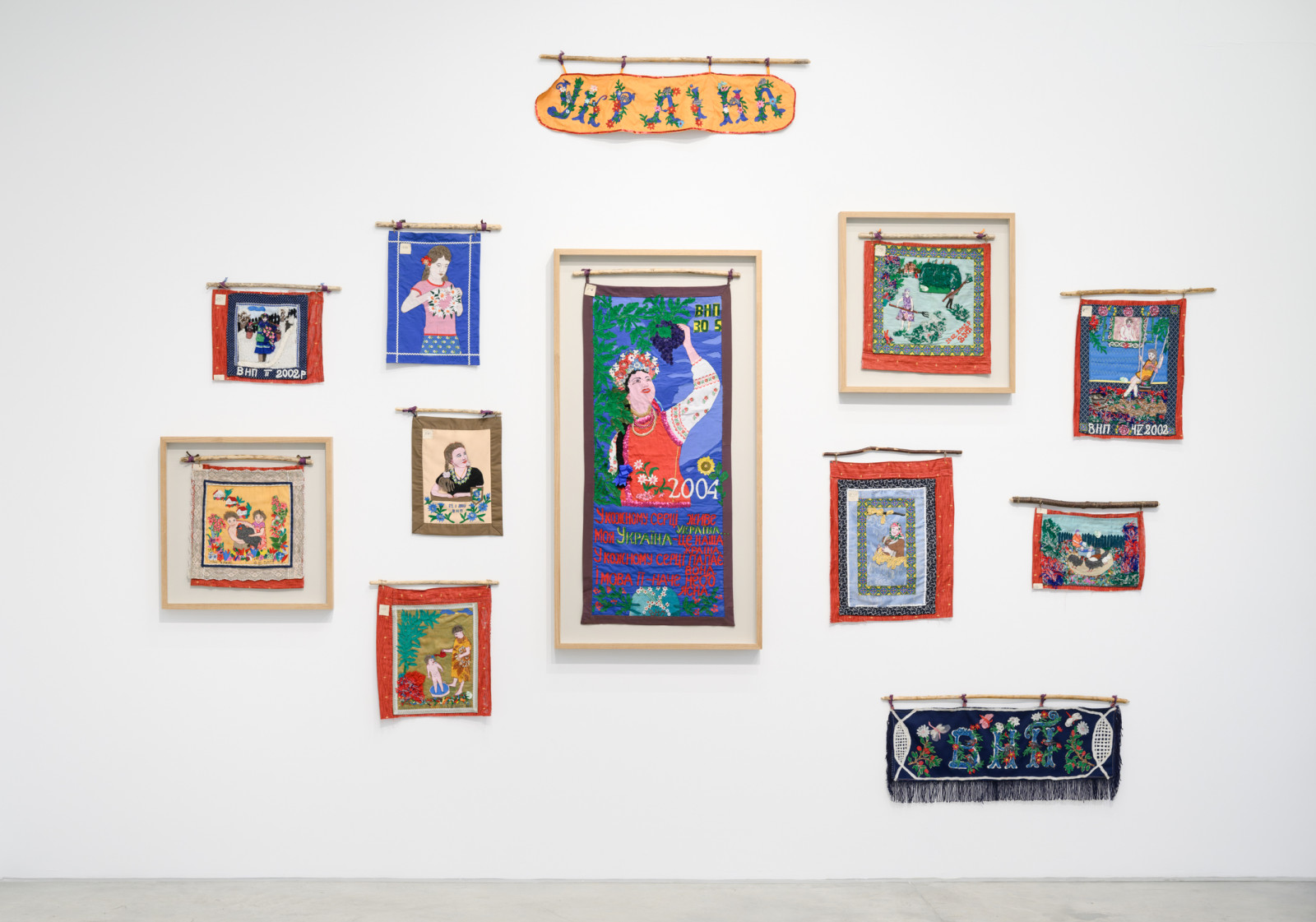'Nina Vynnyk's Ukraine'
-
selected works
View: ,
'Good Morning! (with the Rooster)'
appliqué, fabric, marker 60×103×1cm 2009
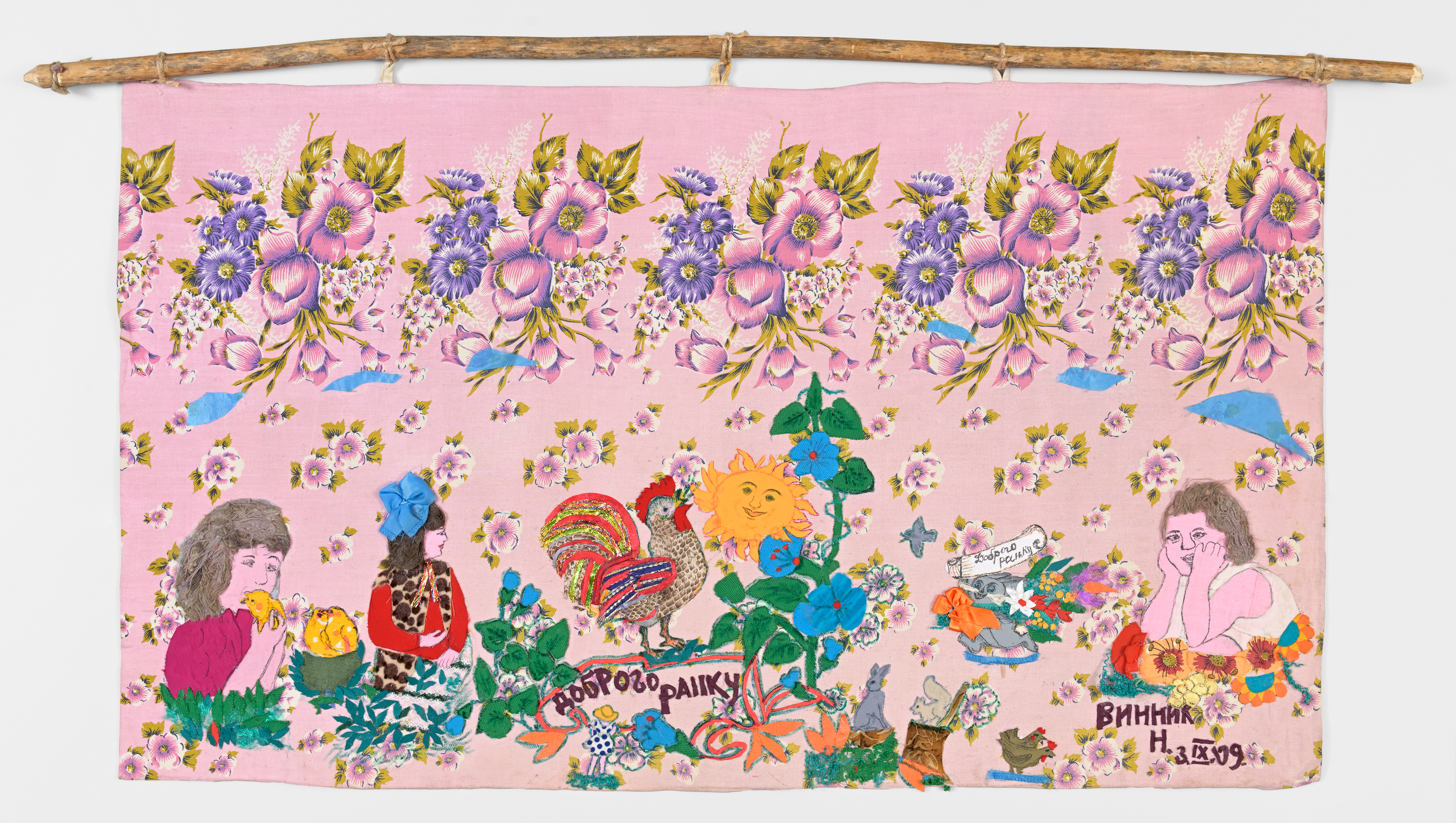

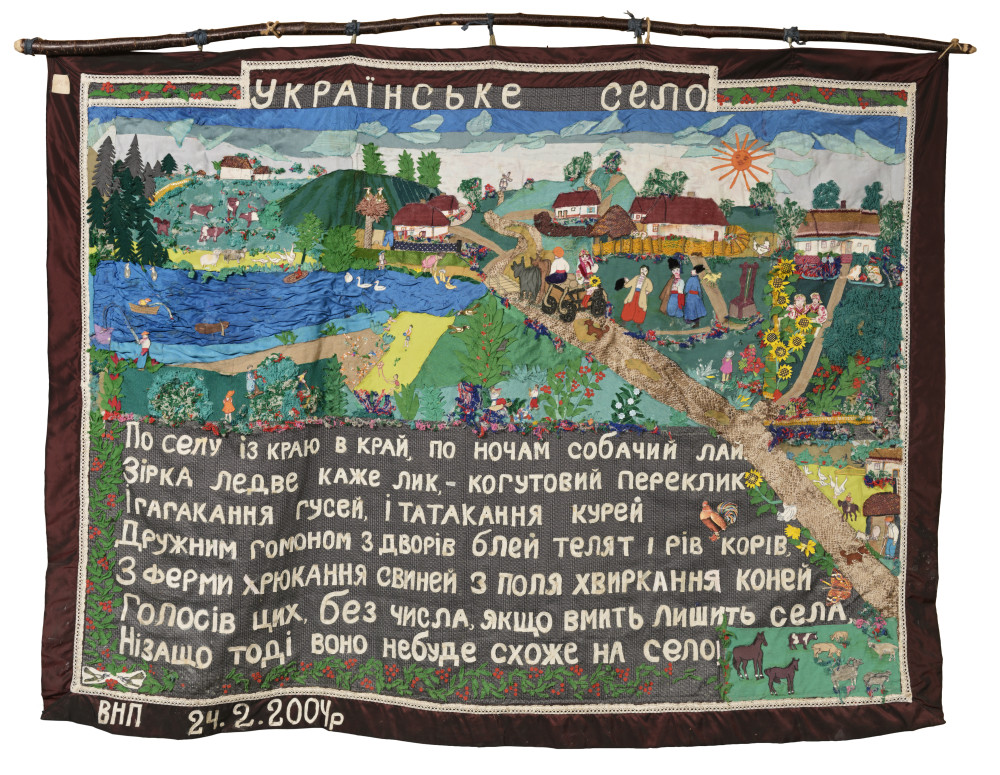
'Ukrainian Village'
appliqué, fabric, marker 123×169cm 2004
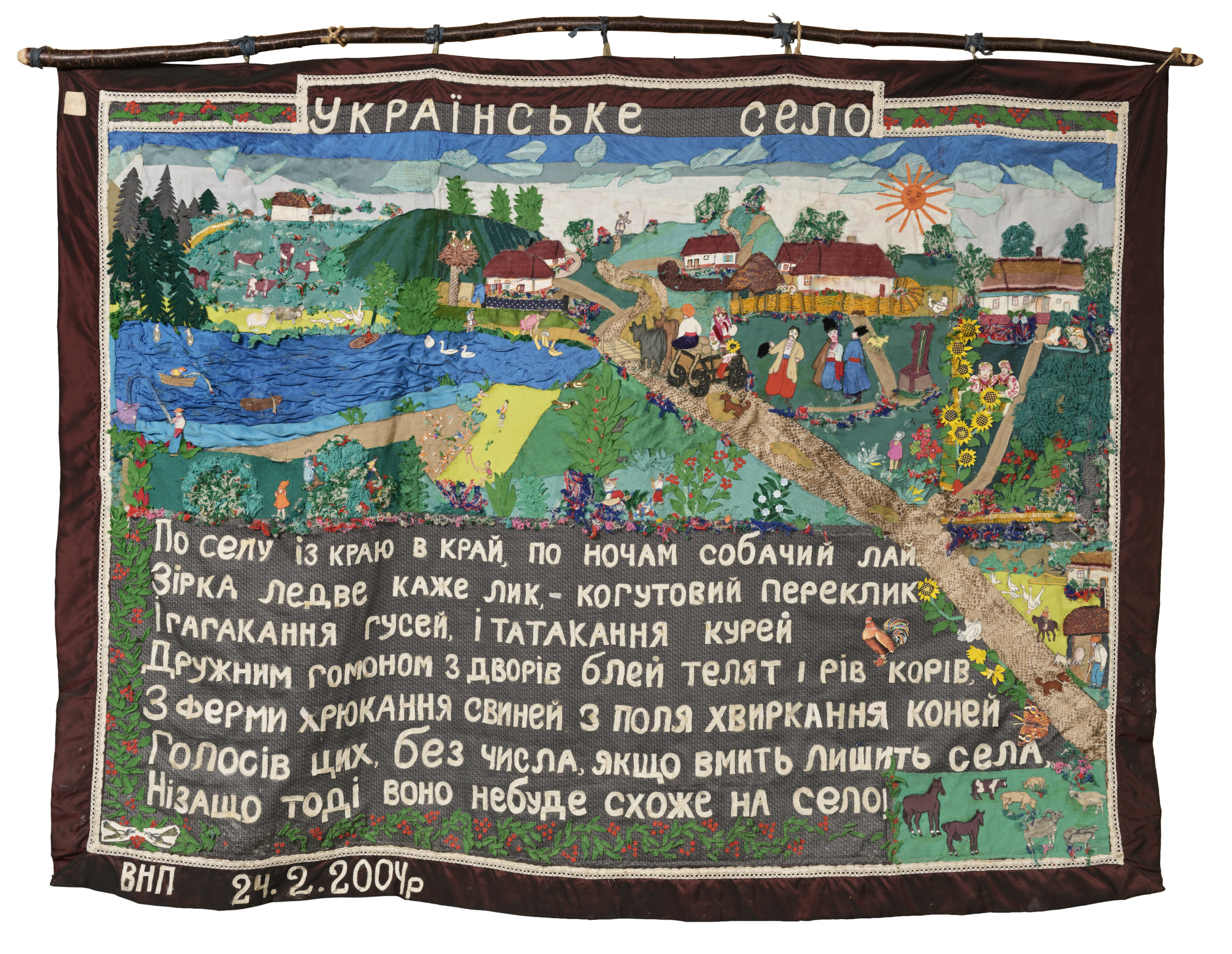
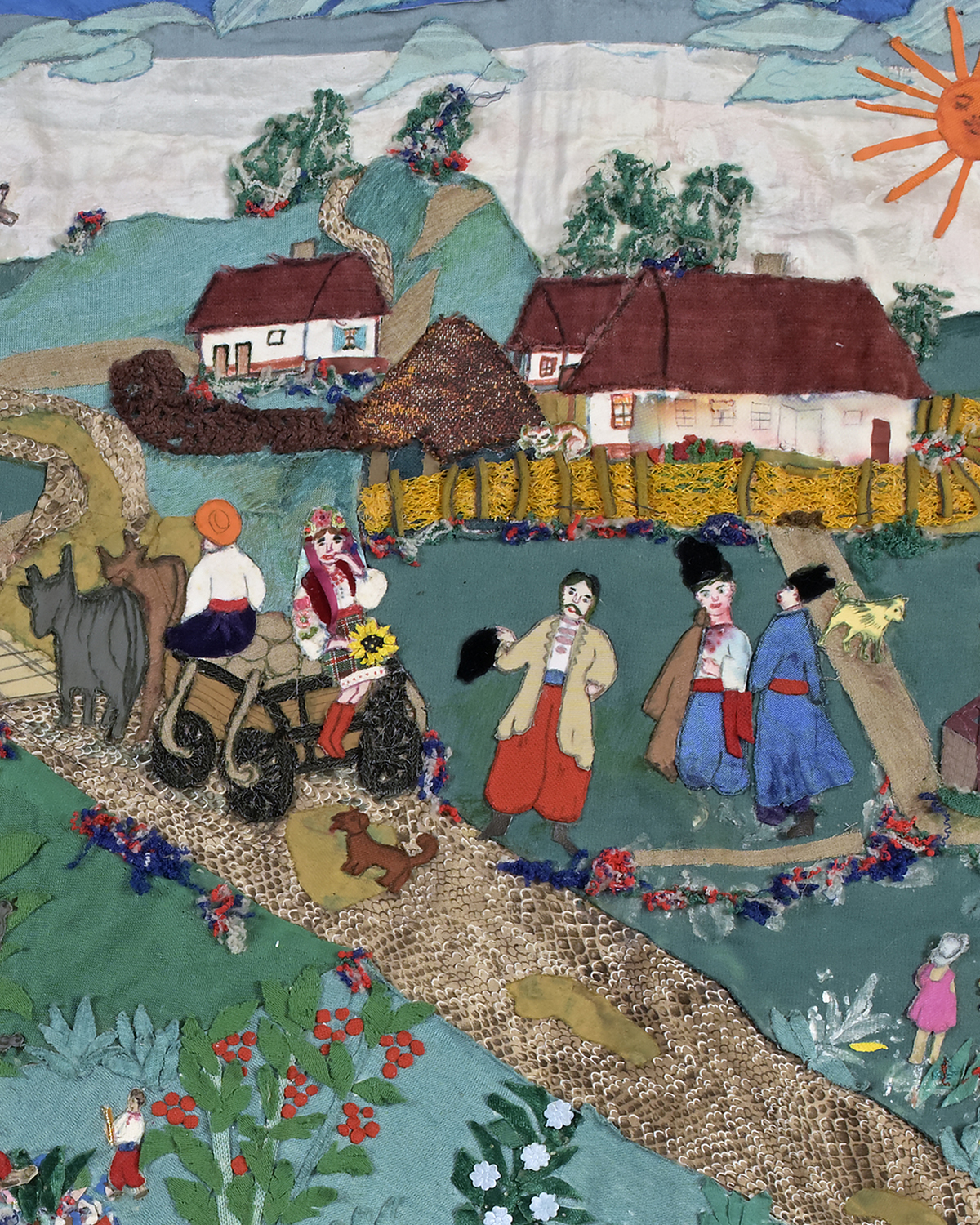

'Ukraine in the Heart'
appliqué, fabric, marker, framed 116×51×1cm 2004
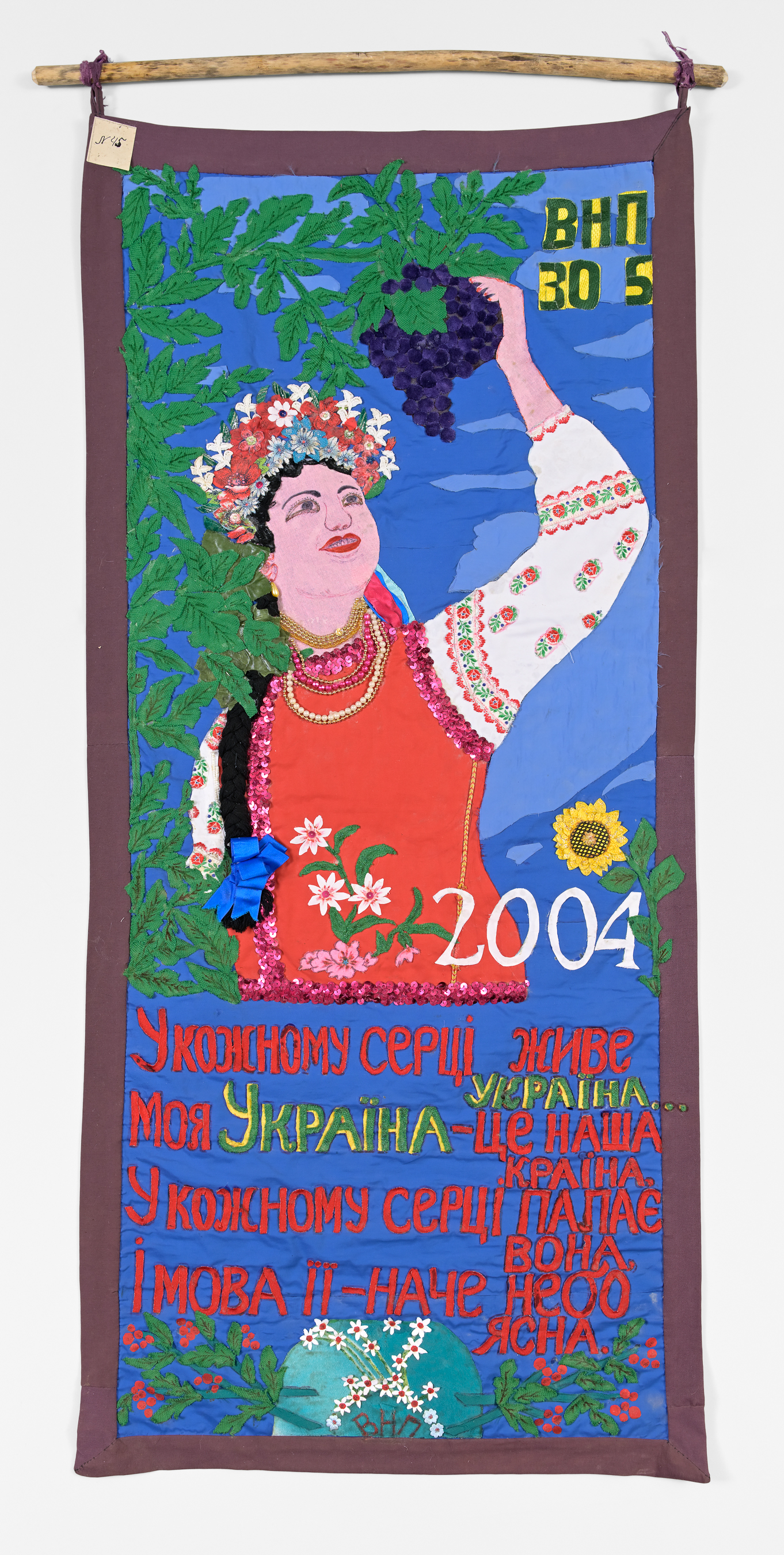
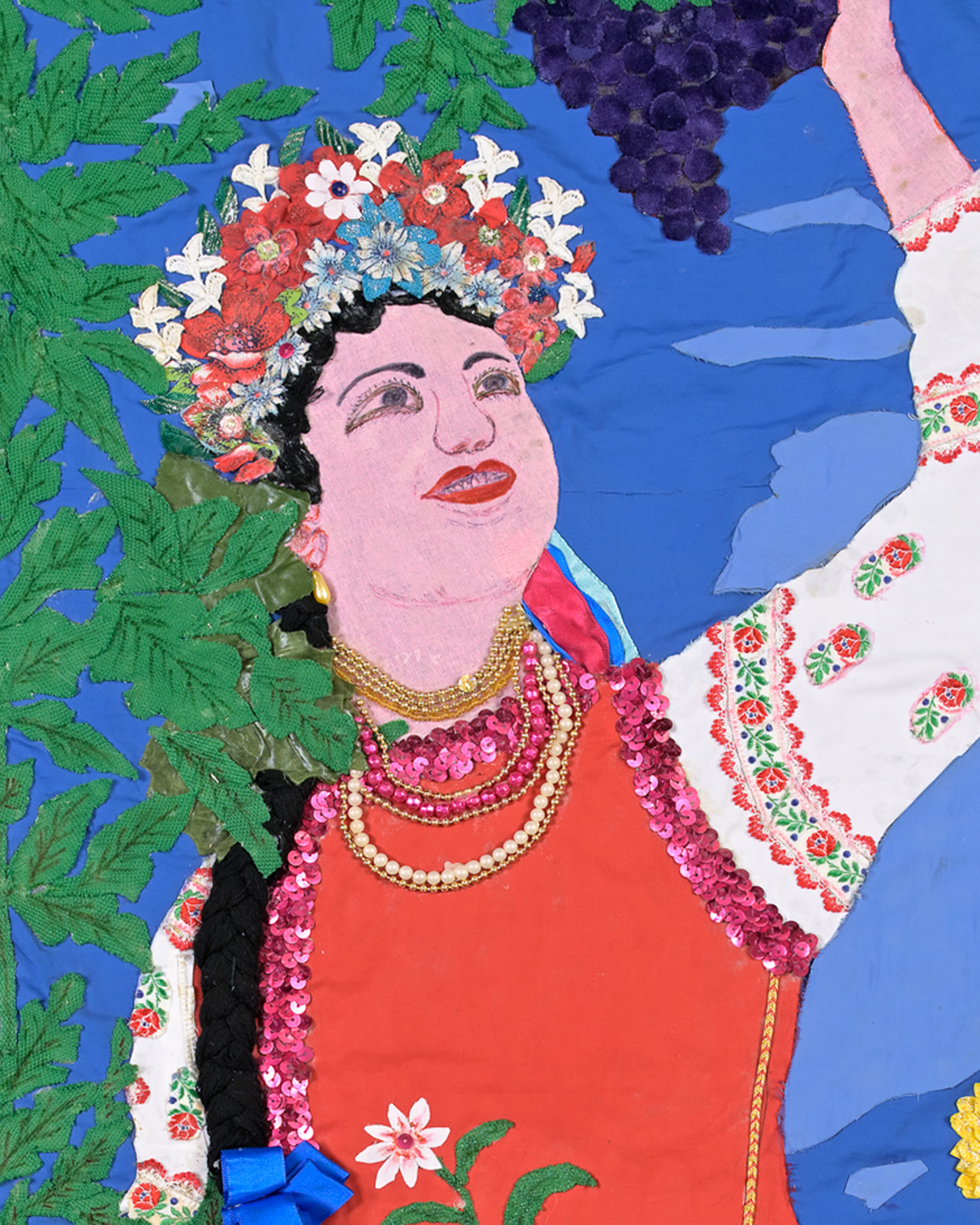

'Christ is Risen. Festive table of the Day of the Holy Resurrection. Easter'
appliqué, fabric, marker 137×125cm 2003
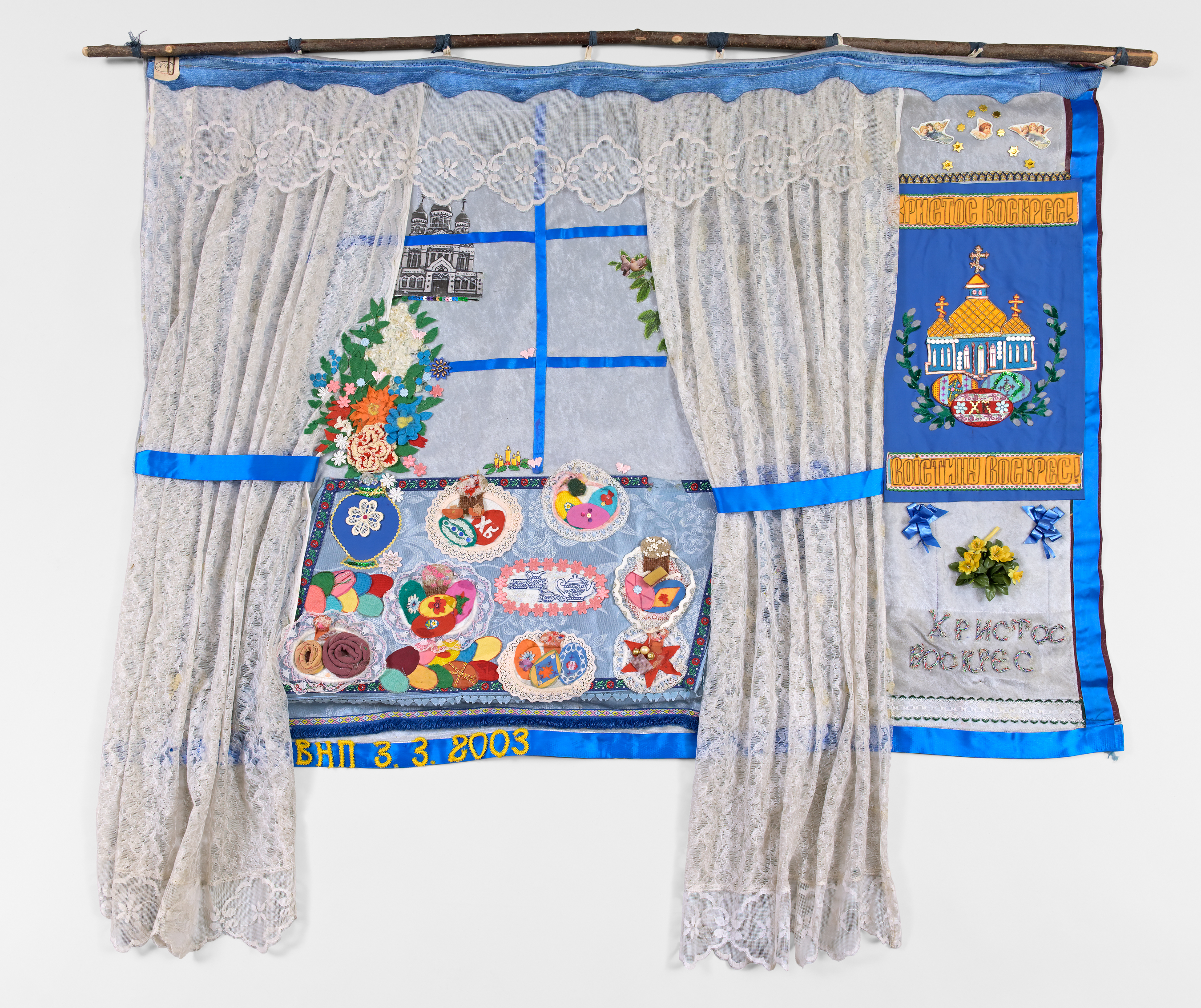
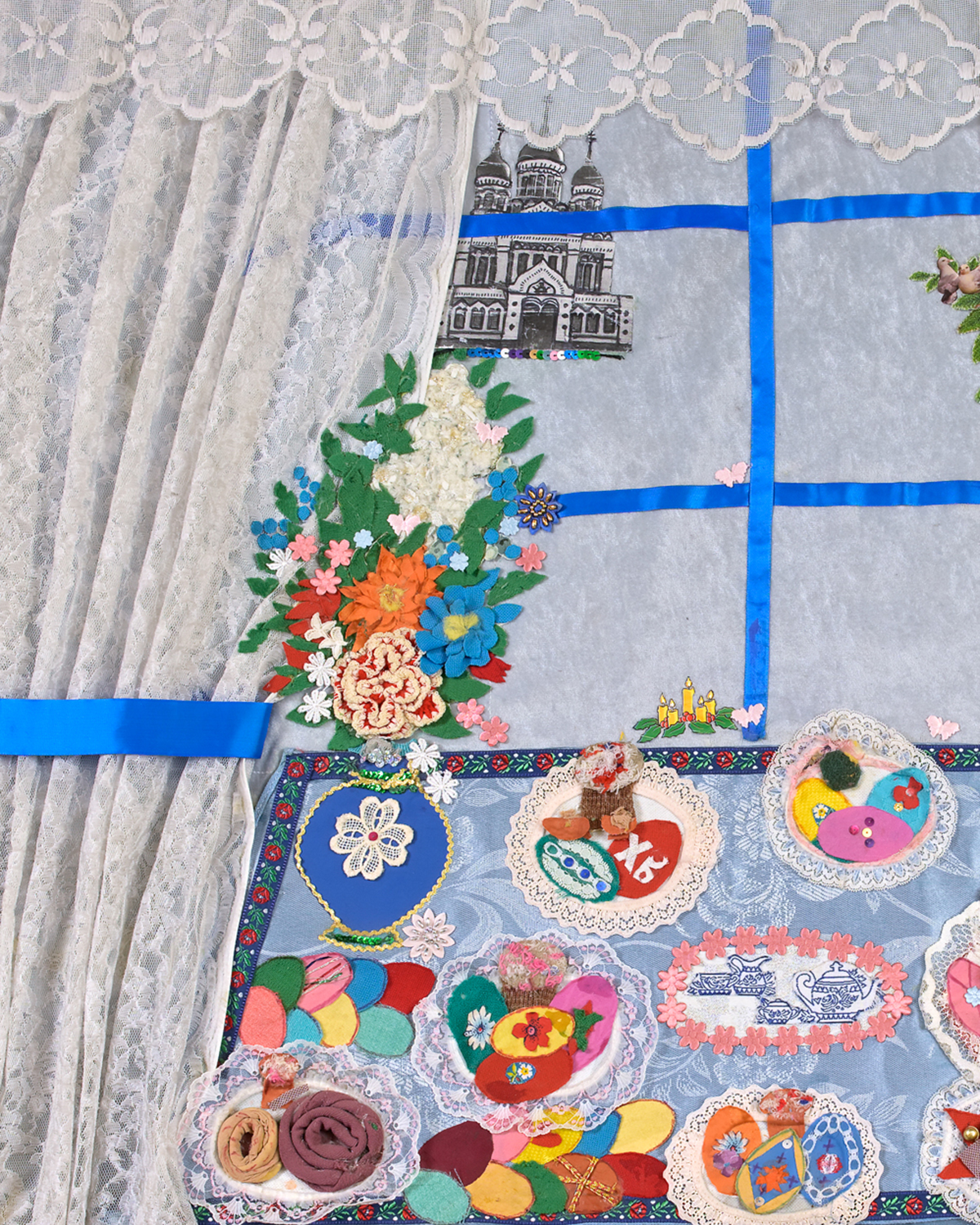

'Visiting Grandma III (Summer is a Wonderful Time. Bathing.)'
appliqué, fabric, marker 44×44×1cm 2003
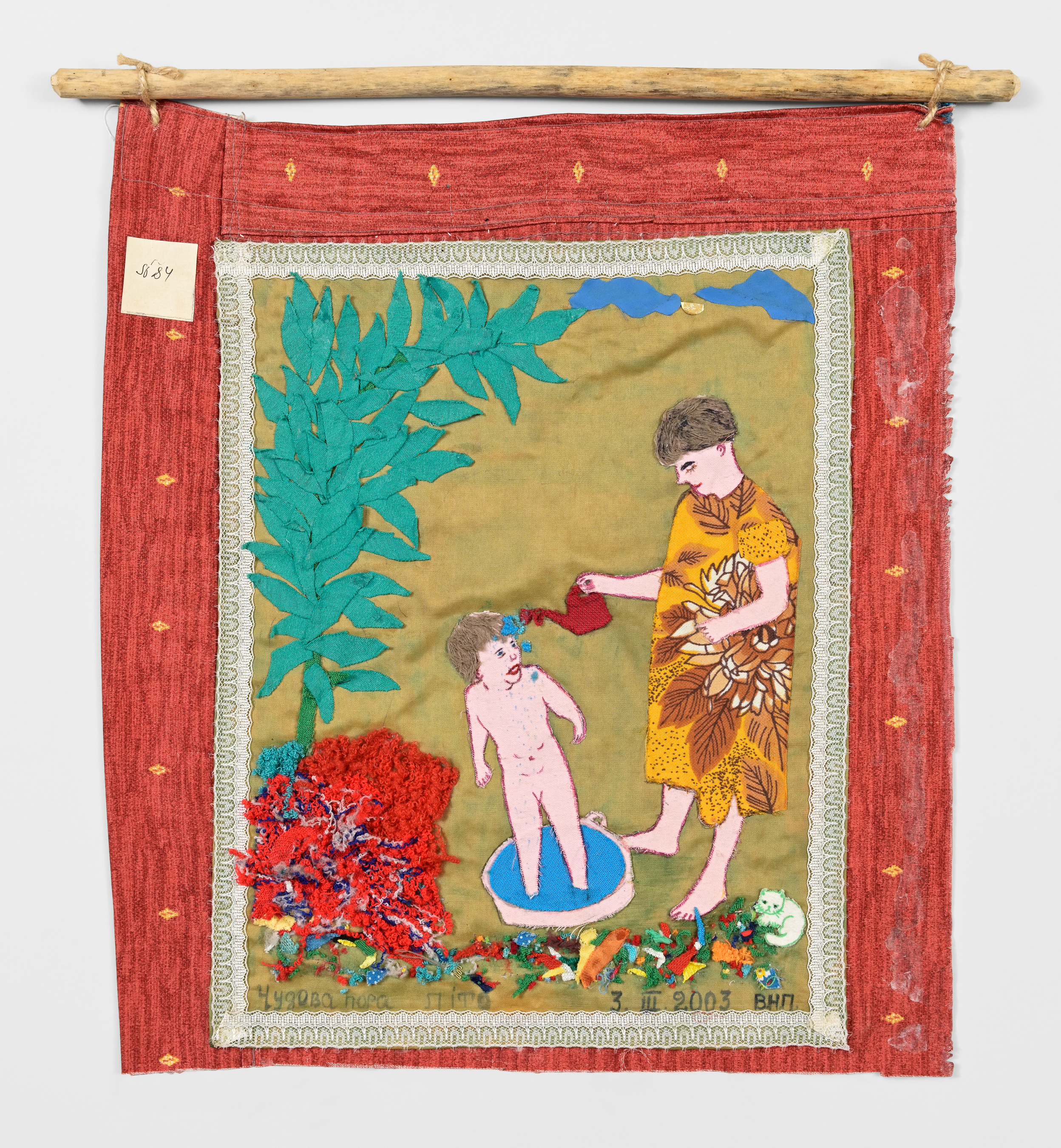
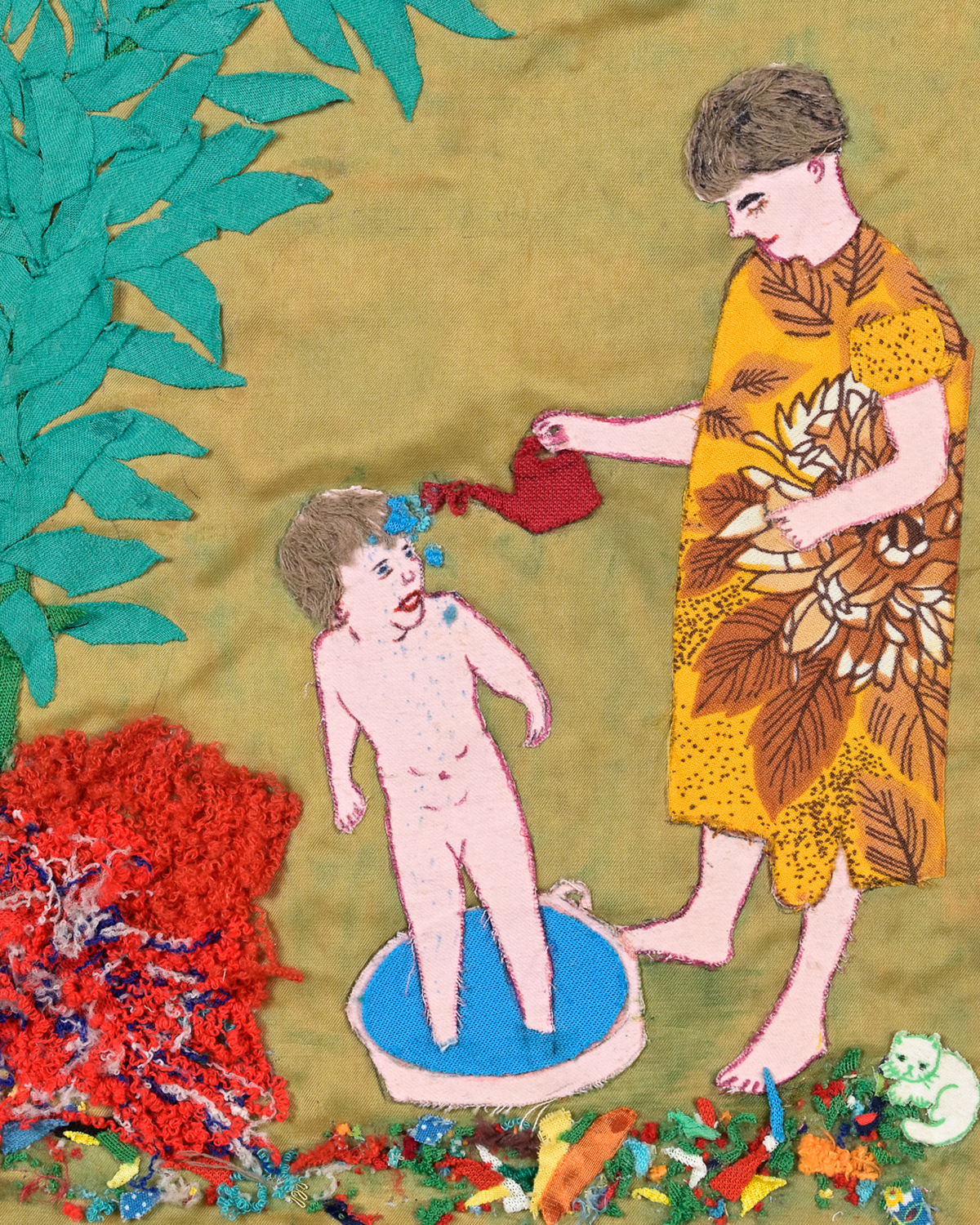

'Visiting Grandma IV (Children with Chicken)'
appliqué, fabric, marker, framed 39×41×1cm 2003

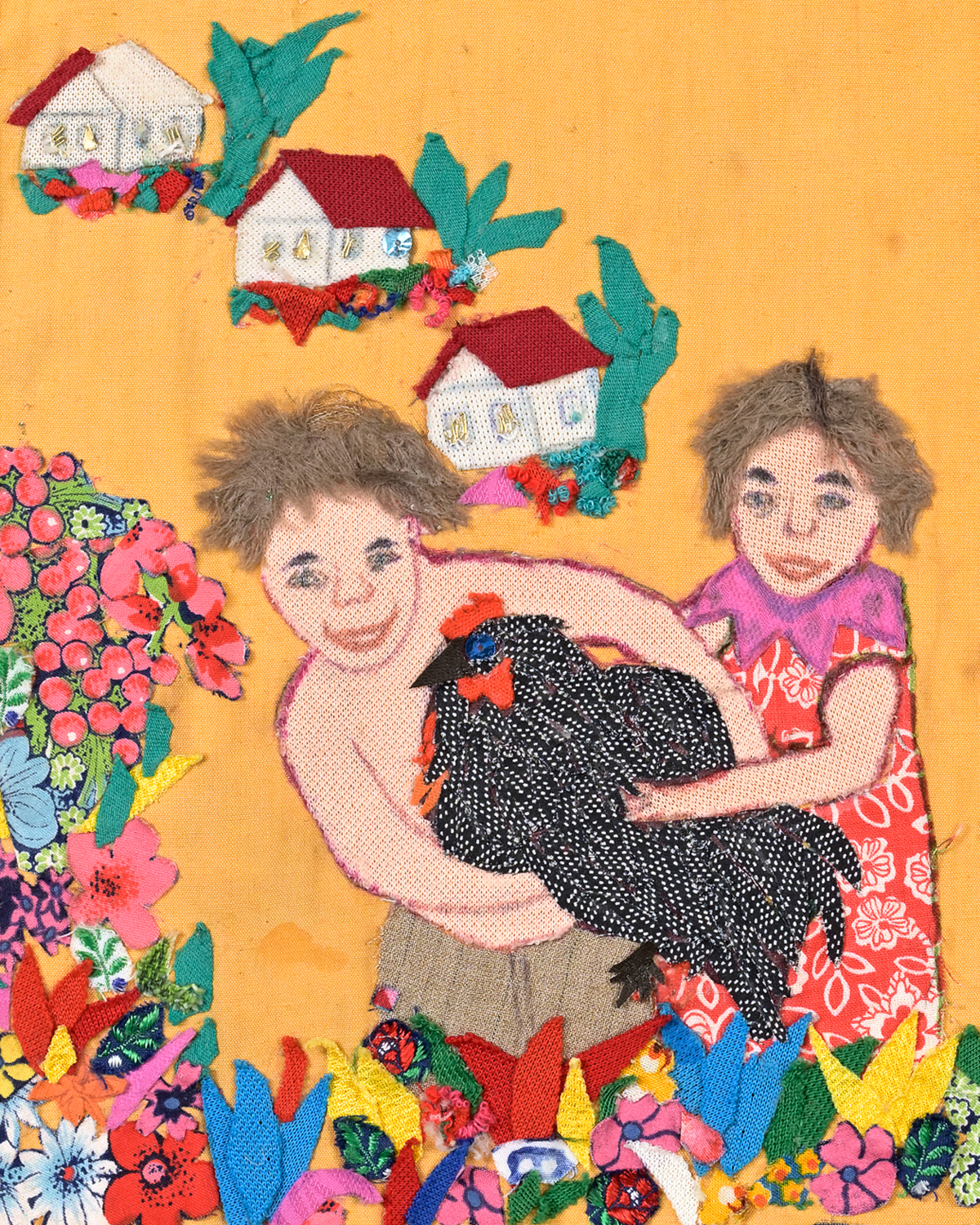

'Visiting Grandma VI (Portrait of a Schoolgirl) '
appliqué, fabric, marker 40×31×1cm 2003
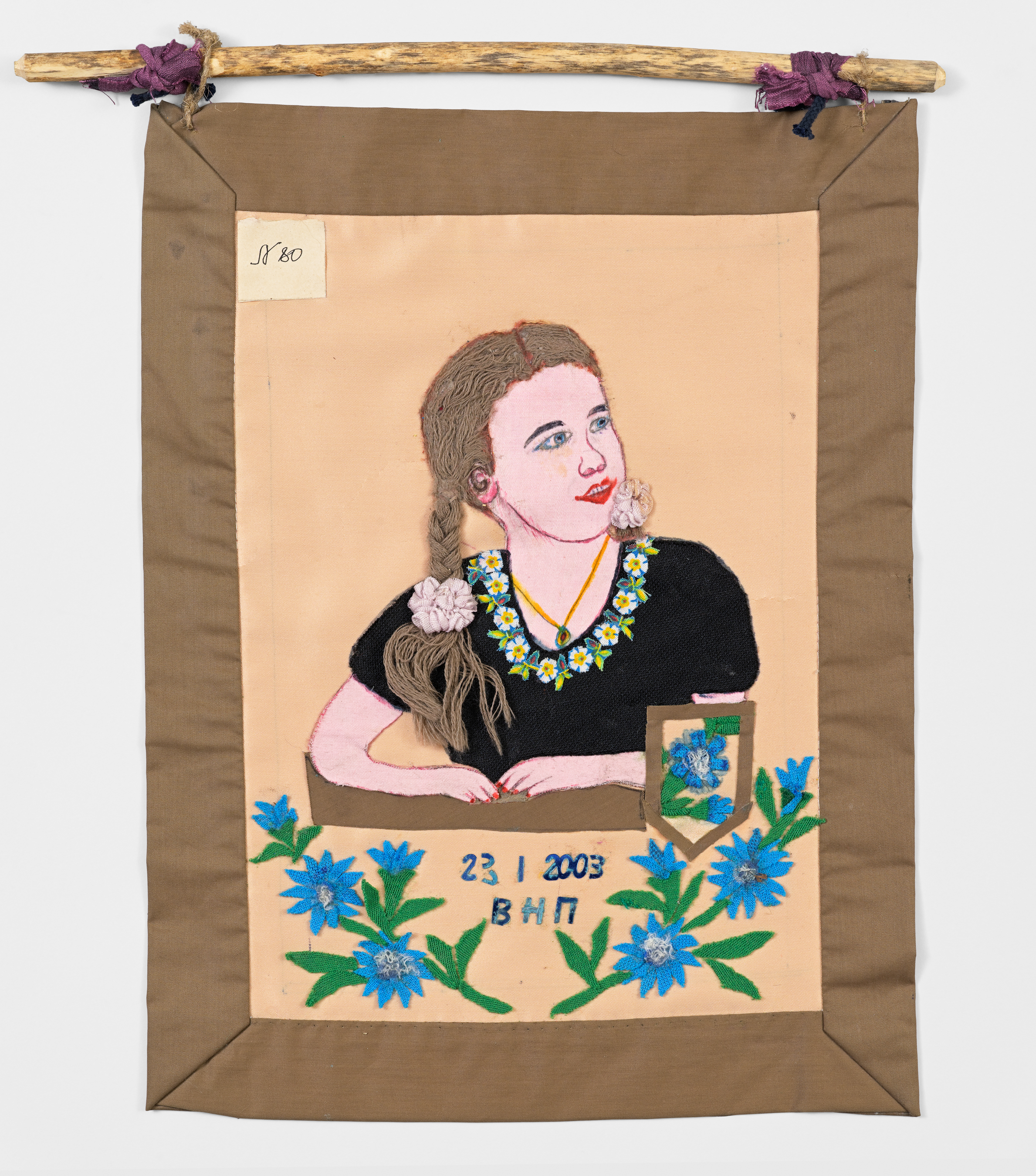
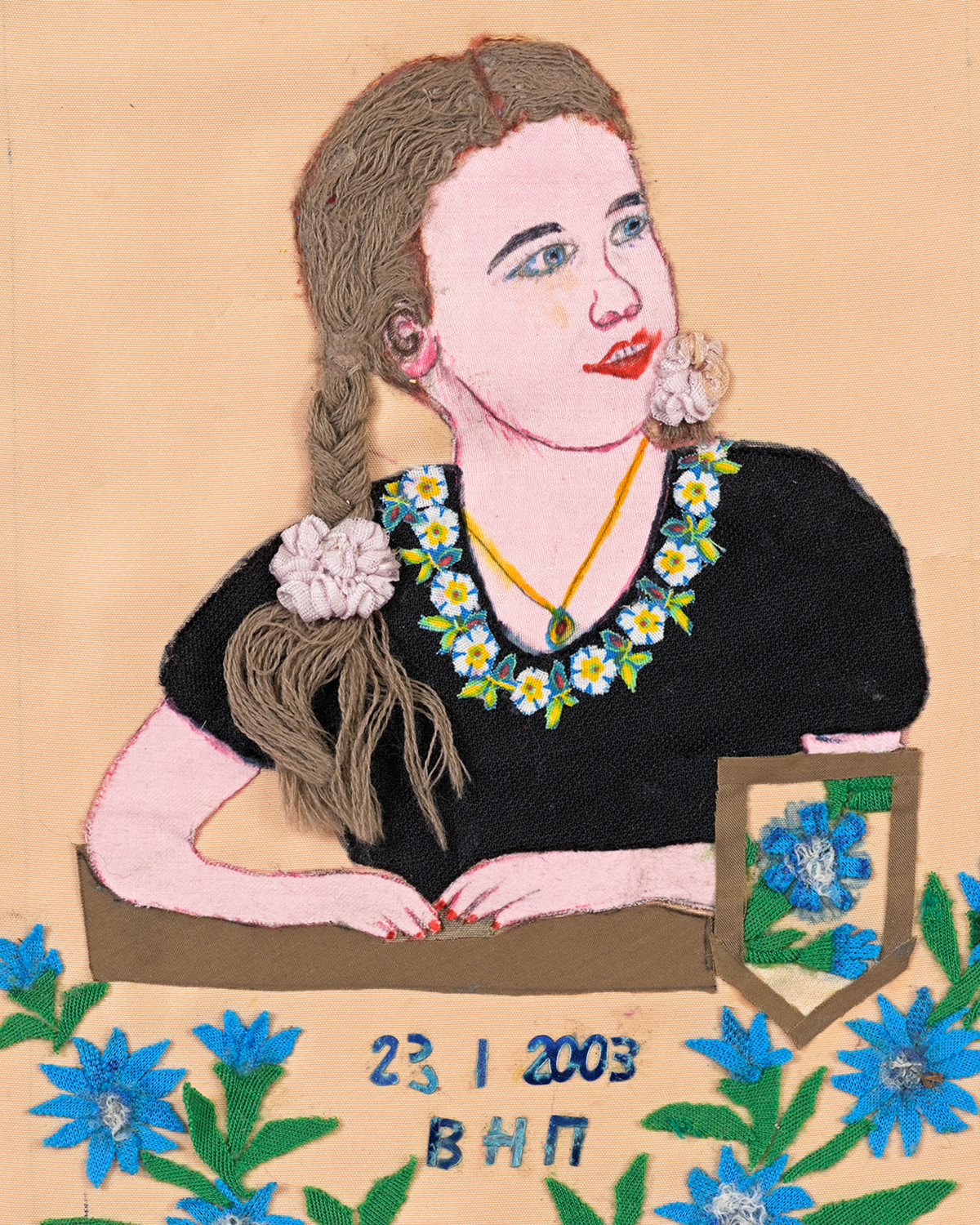

'Ukrainian Village (Portraits)'
appliqué, fabric, marker 183×145×1cm 2002
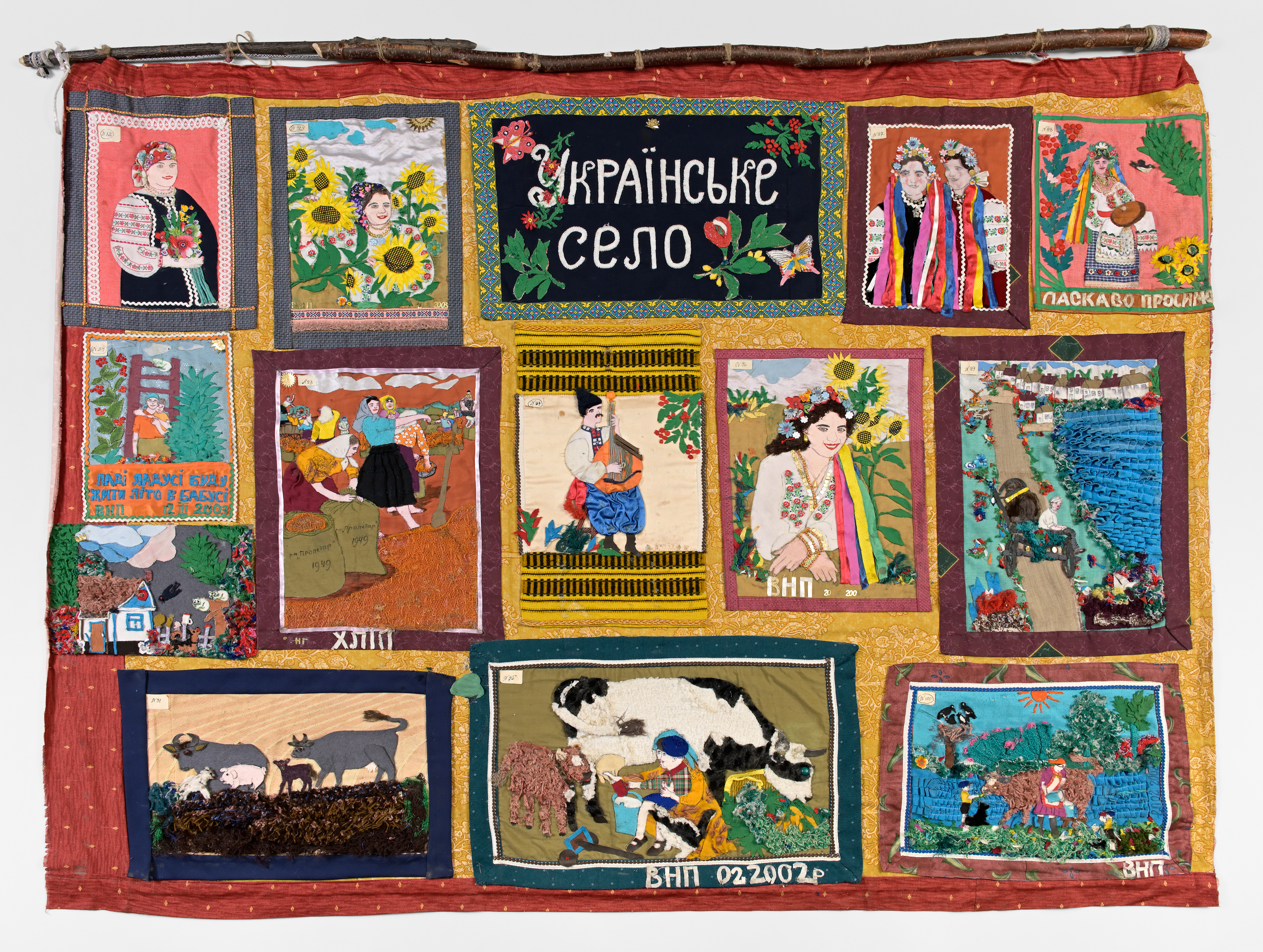
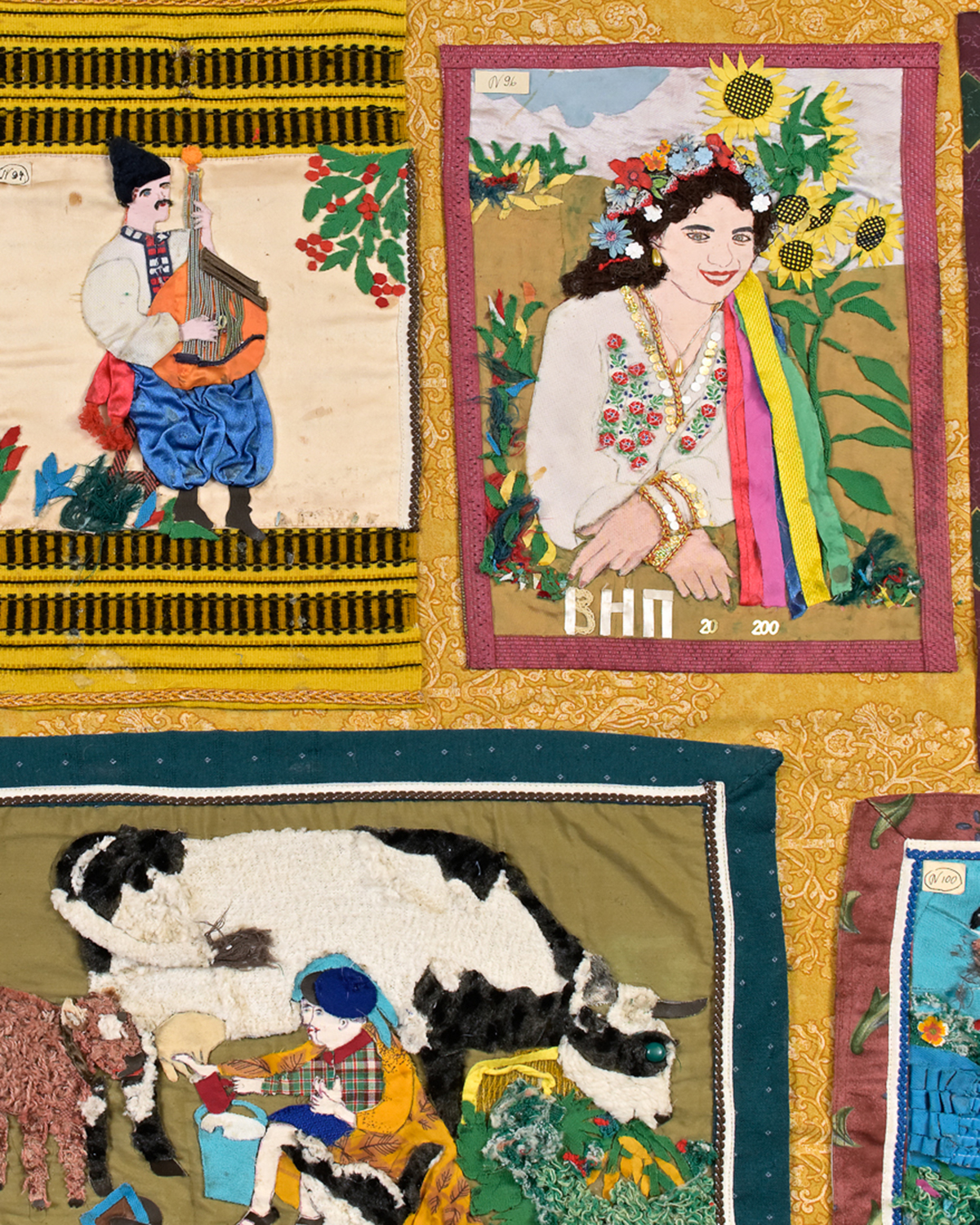

'Visiting Grandma I'
appliqué, fabric, marker 48×39×1cm 2002
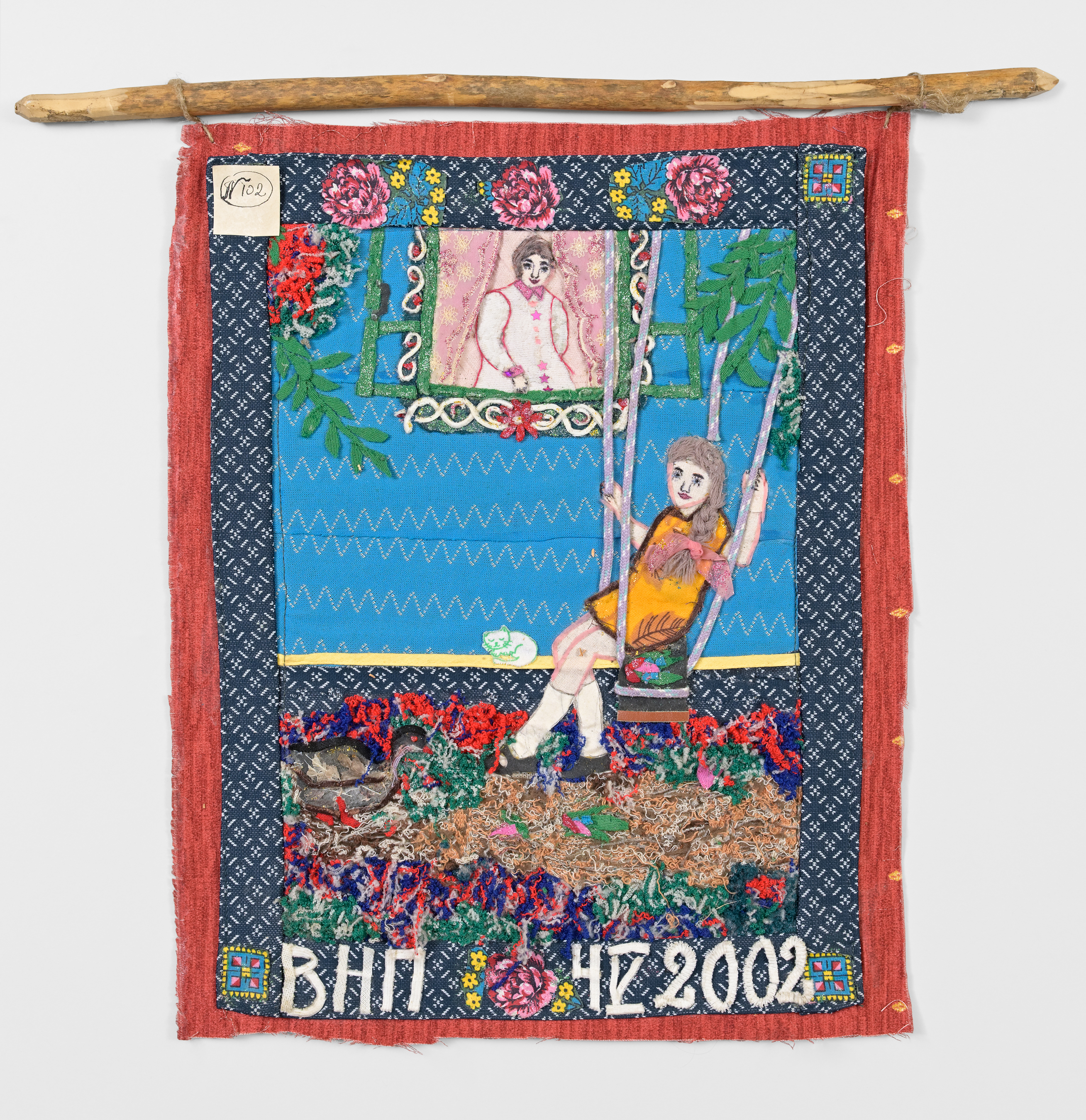
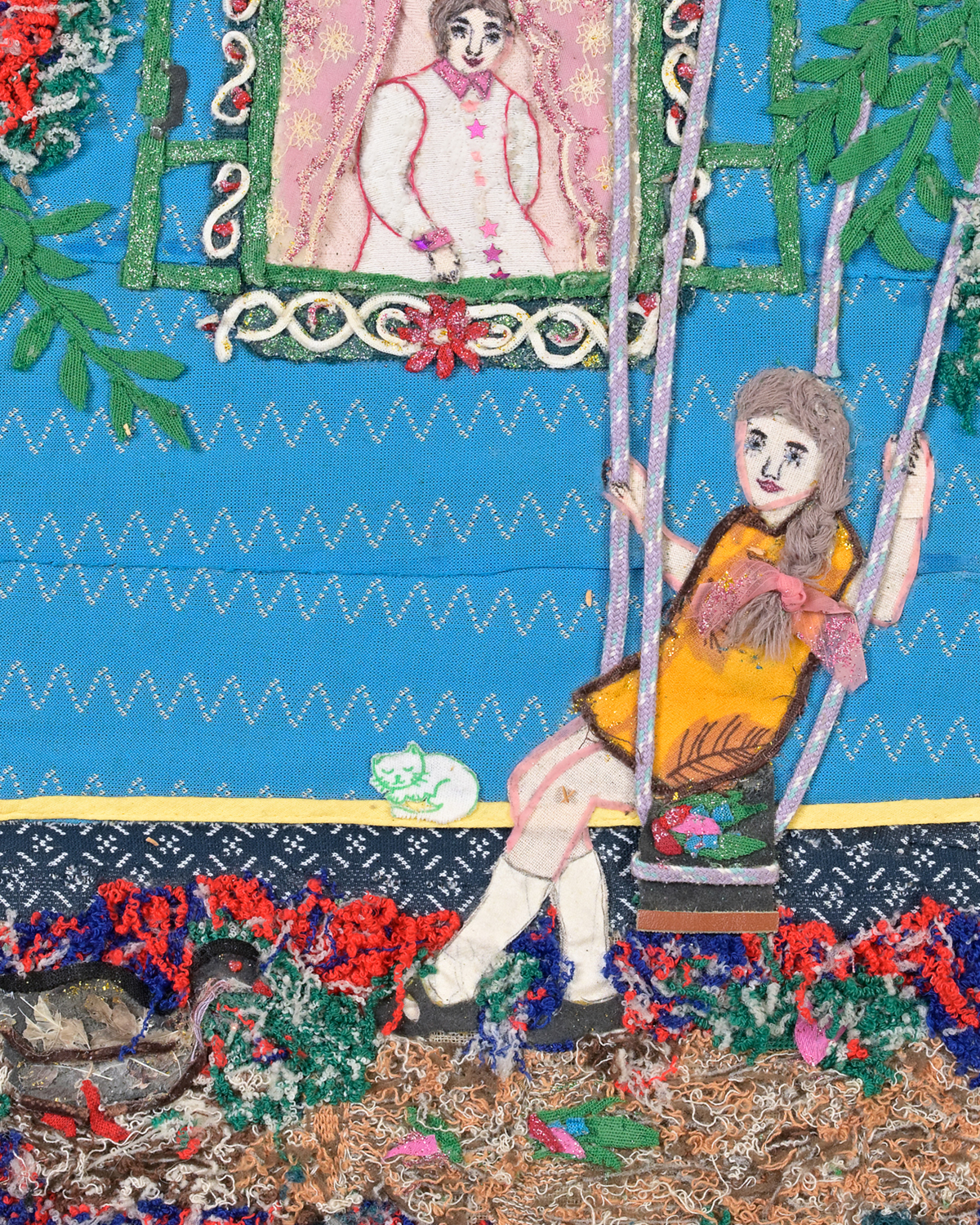

'Visiting Grandma II'
appliqué, fabric, marker, framed 44×44×1cm 2002
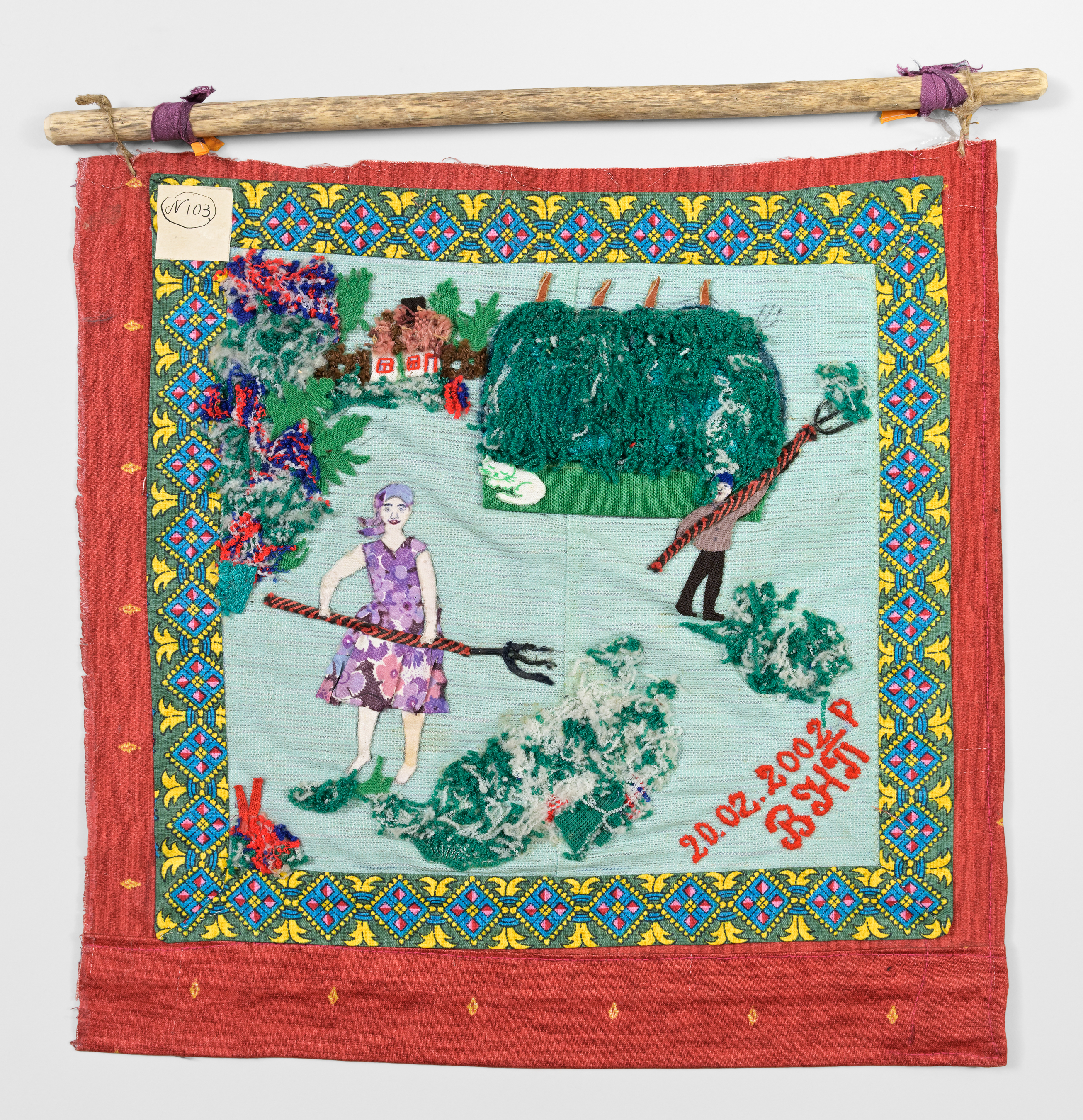
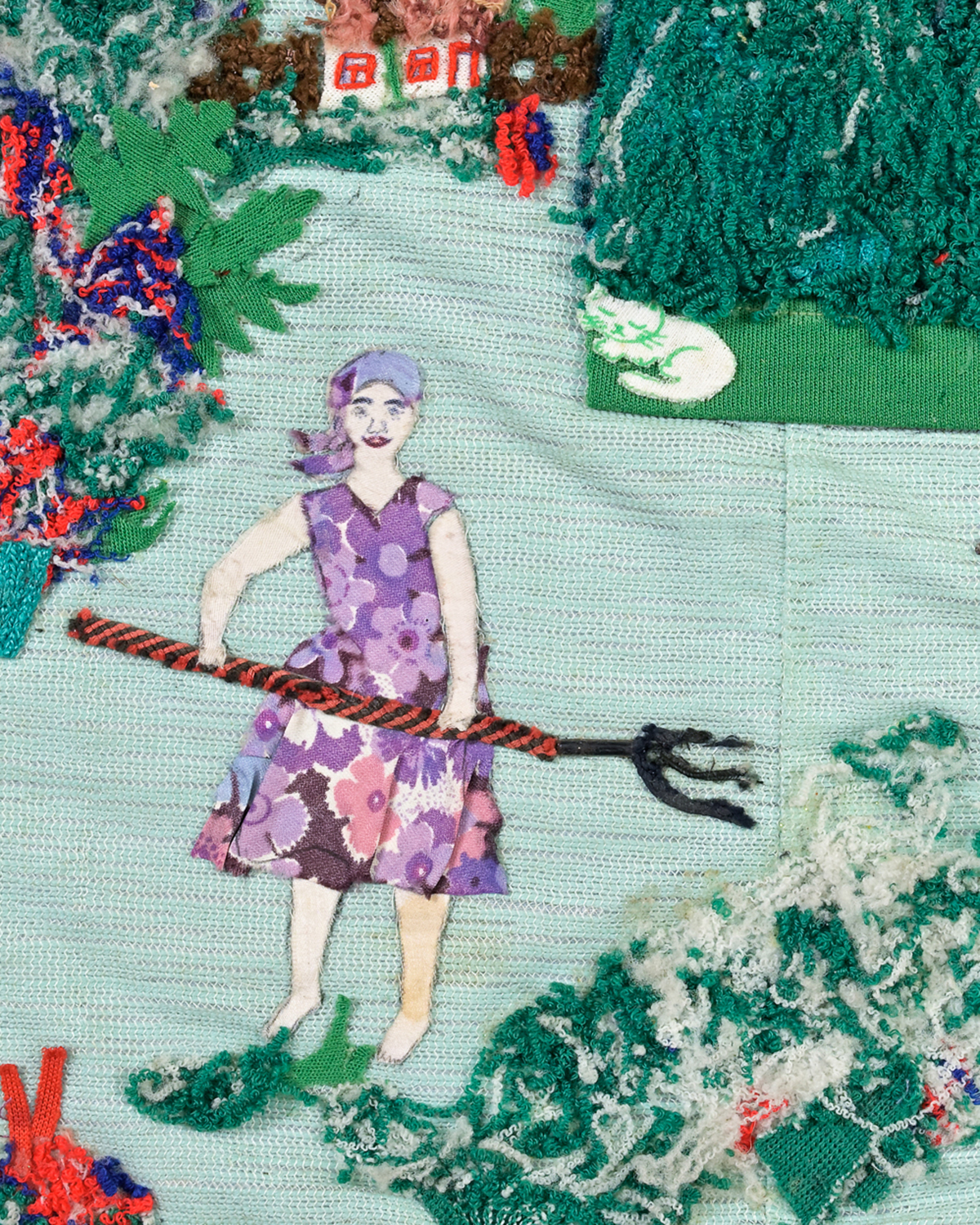

'Visiting Grandma VII (Girl with a Rocker)'
appliqué, fabric, marker 31×38×1cm 2002
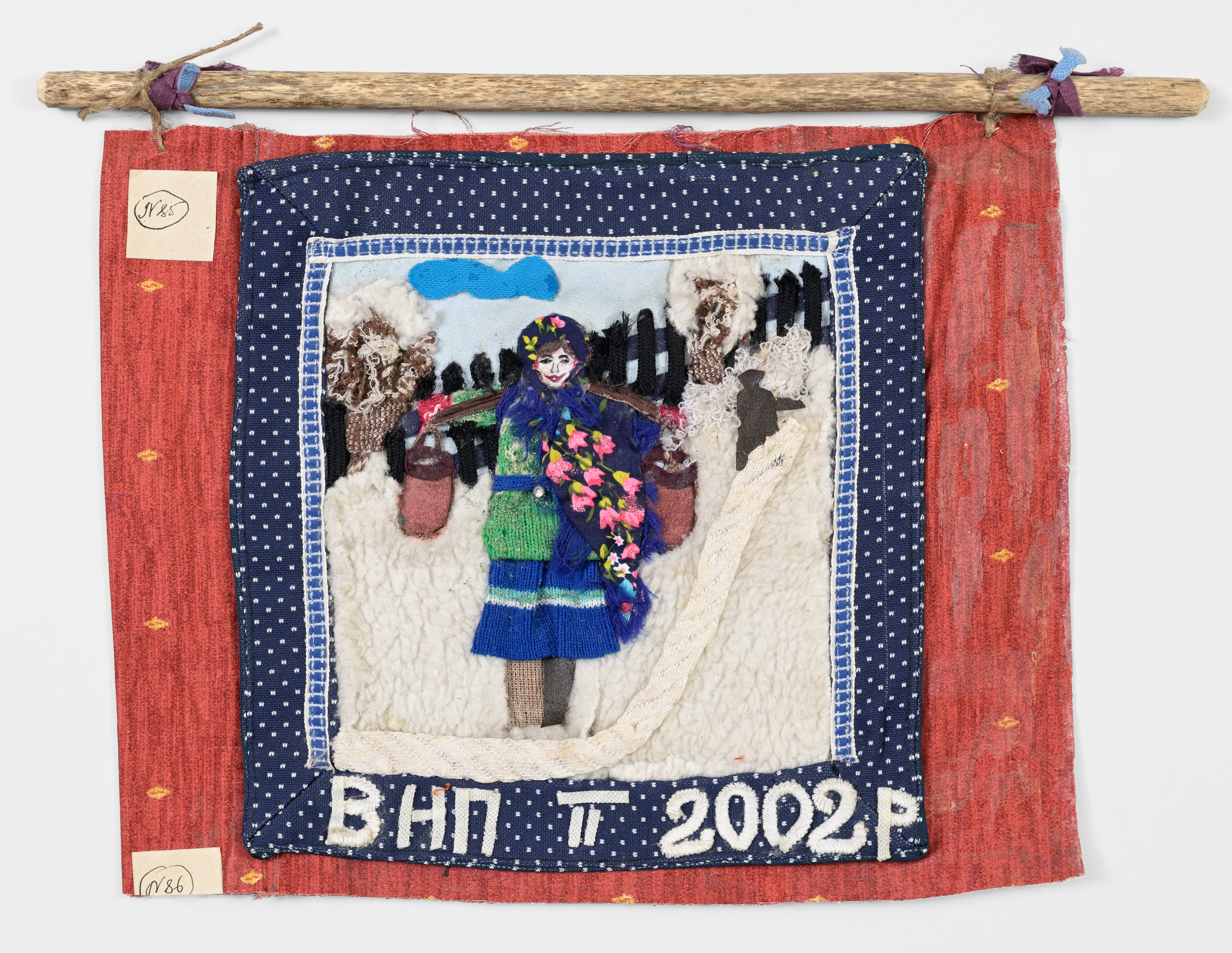
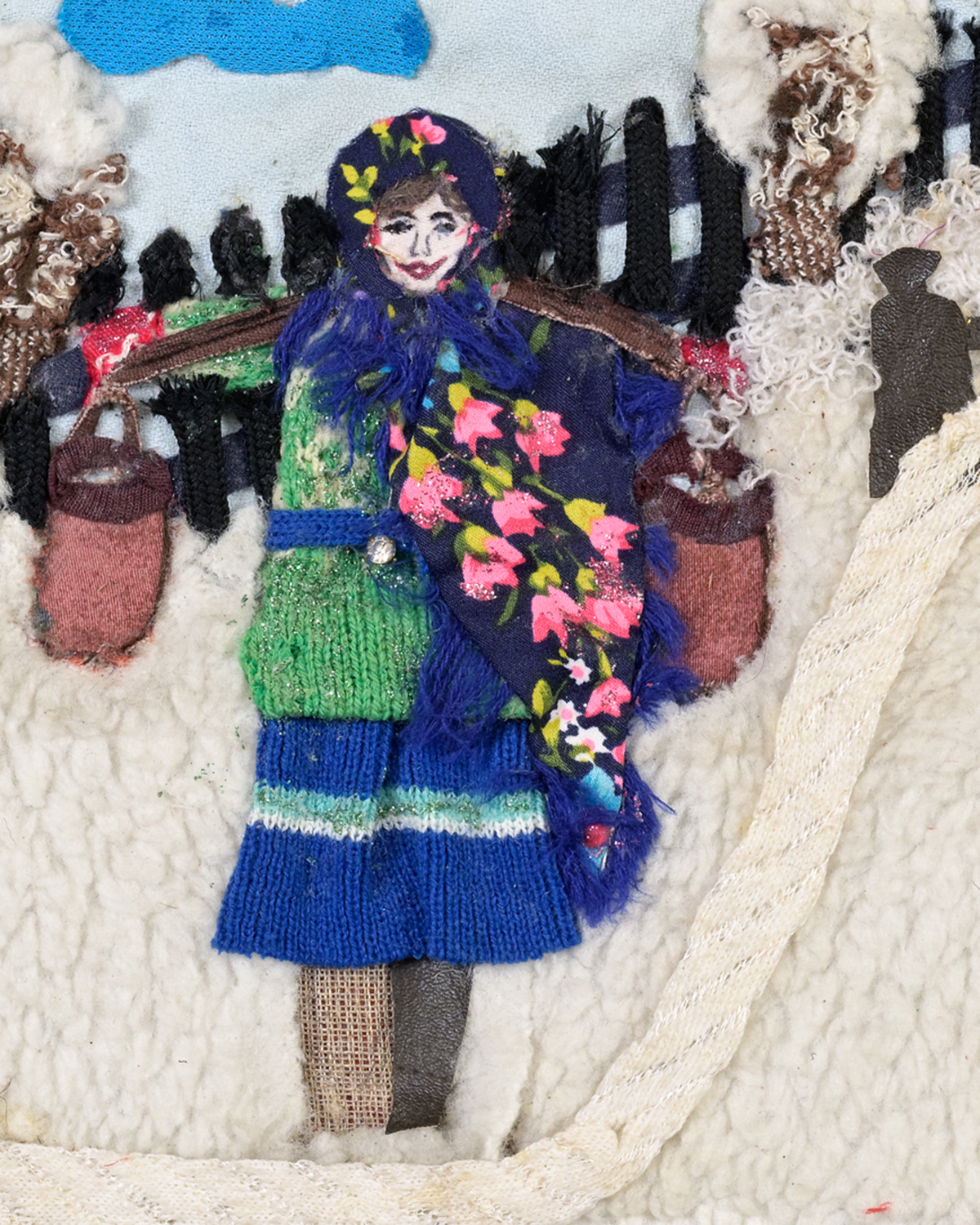

'Ukrainian House with a Bridge Over The River'
appliqué, fabric, marker 172×72×1cm 2001
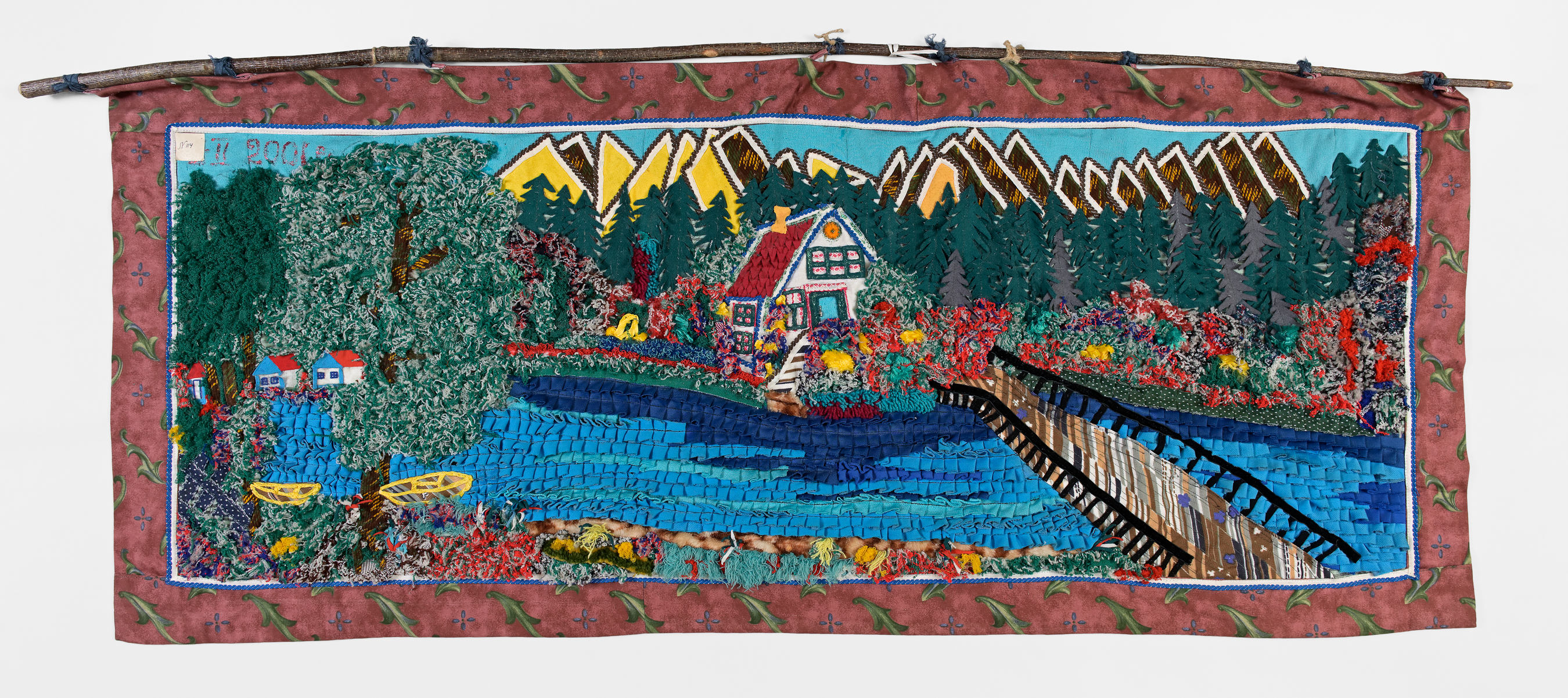
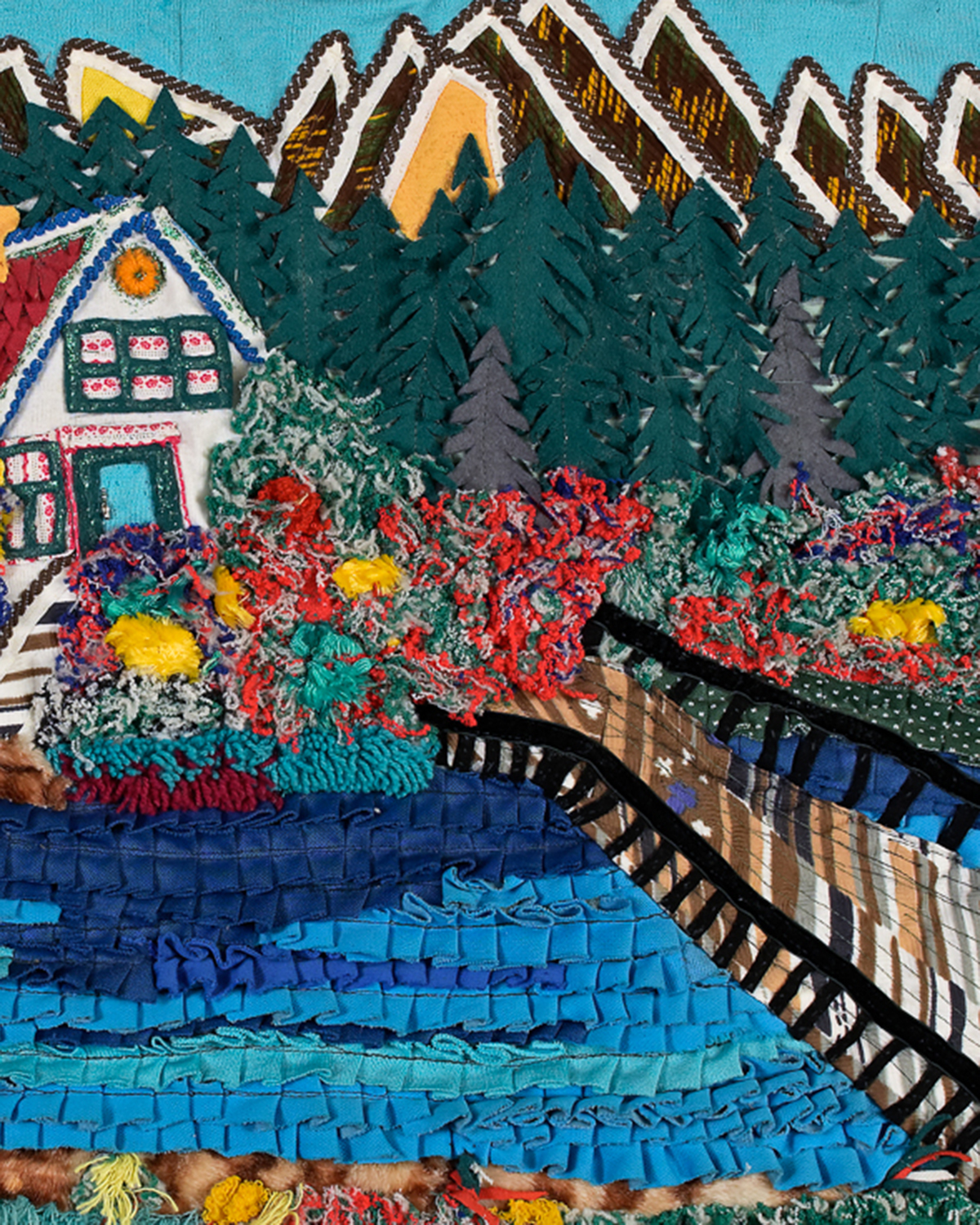

'Winter. Happy New Year!'
appliqué, fabric, marker 124×73×1cm 2001
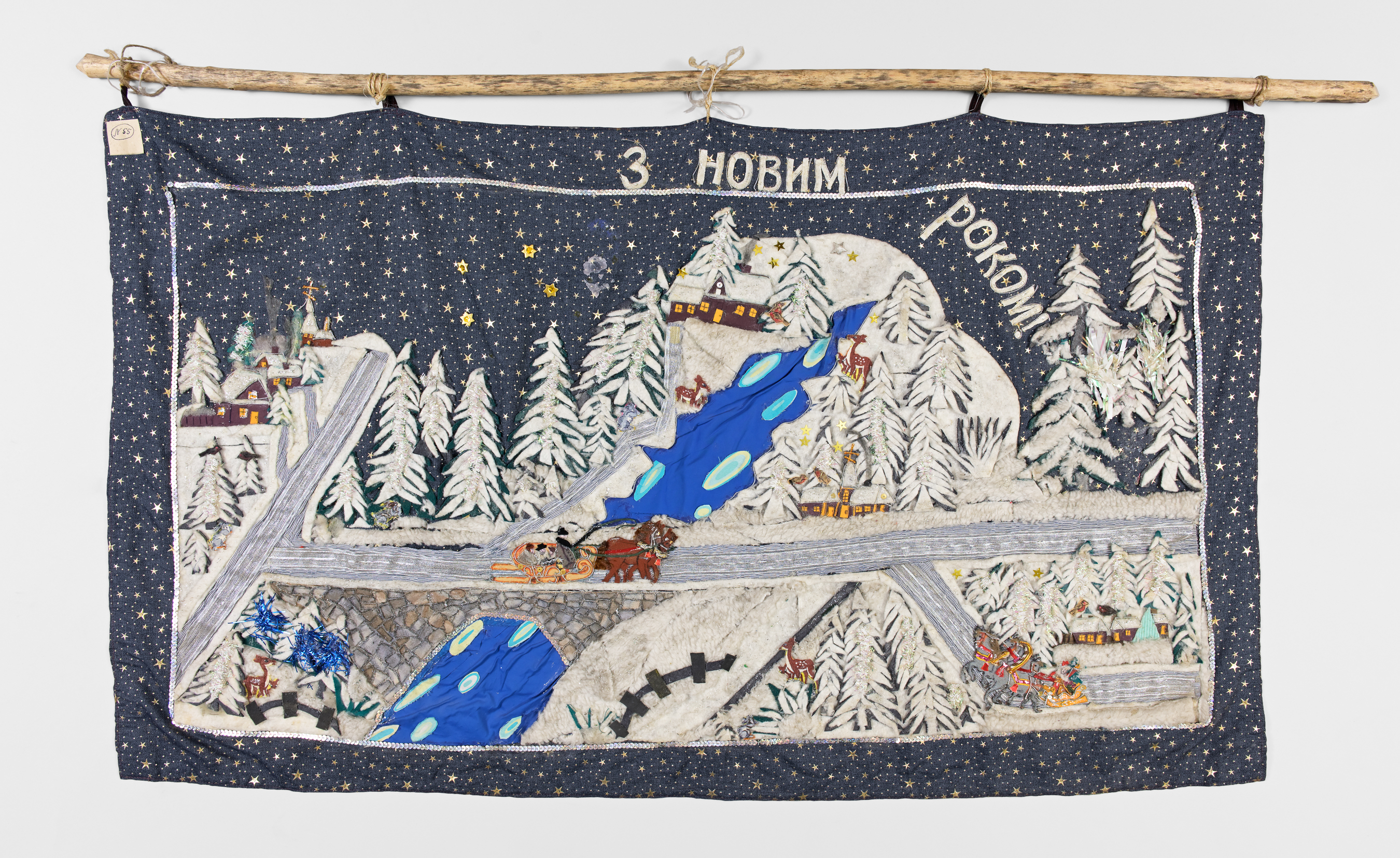
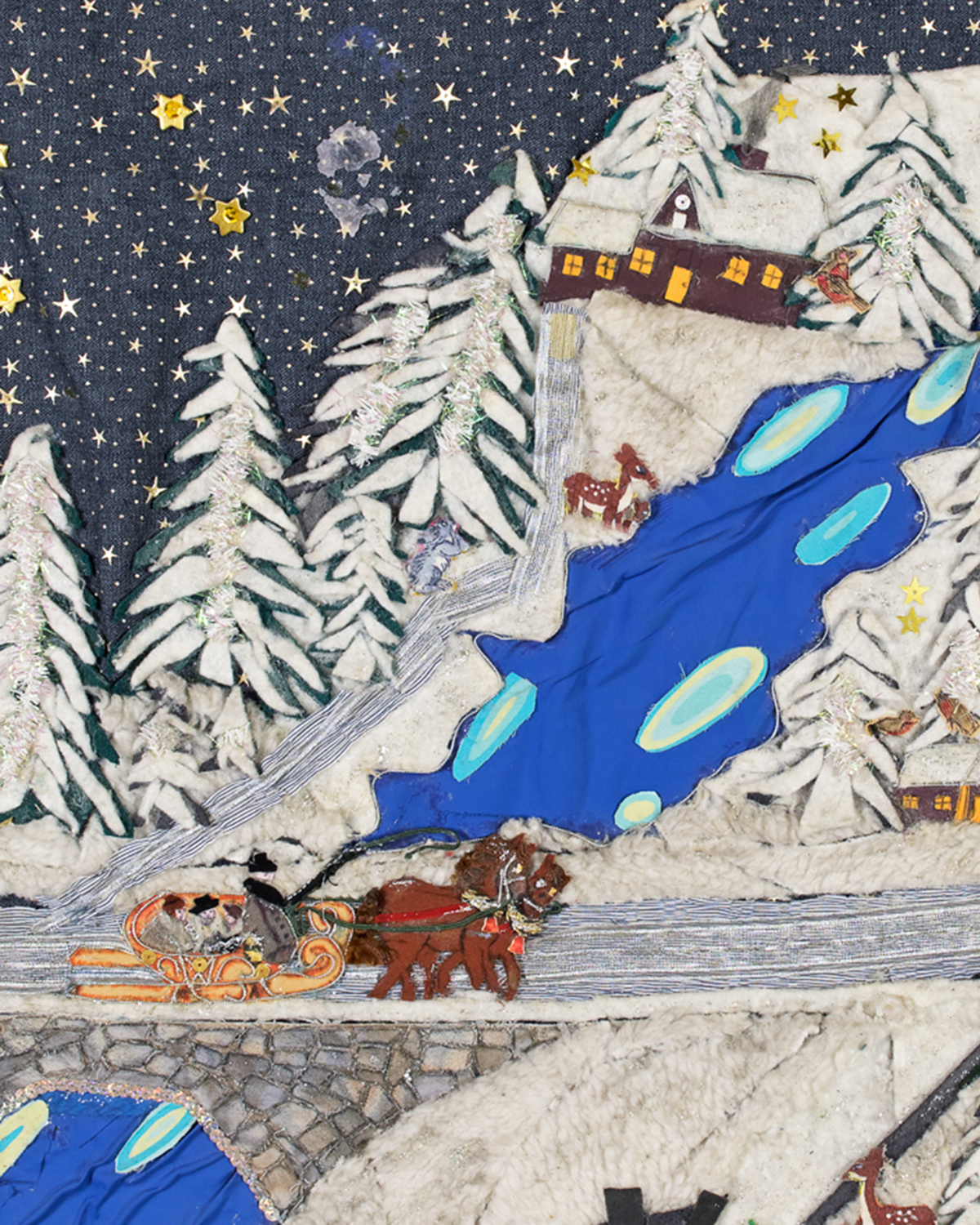

'My Ukraine'
appliqué, fabric, marker 82×190×1cm
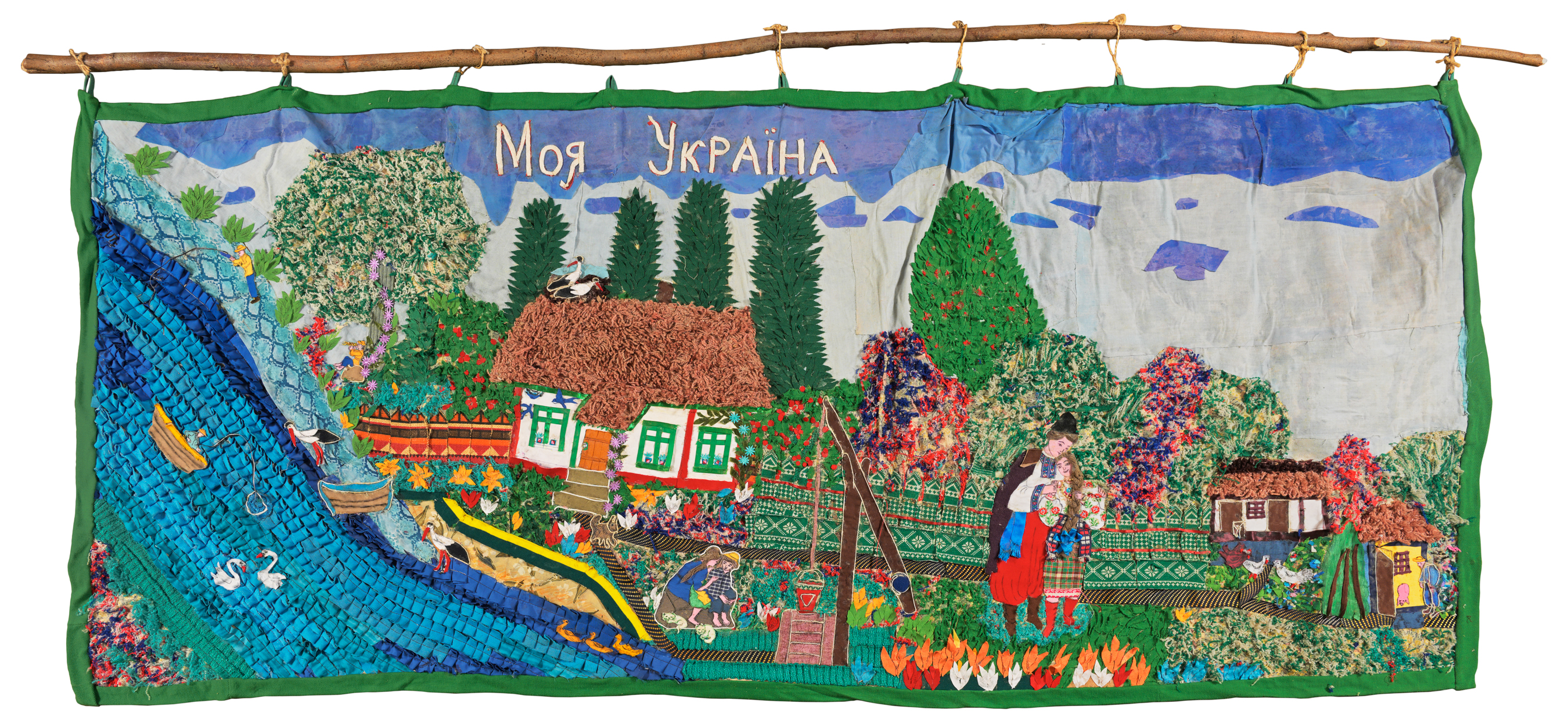
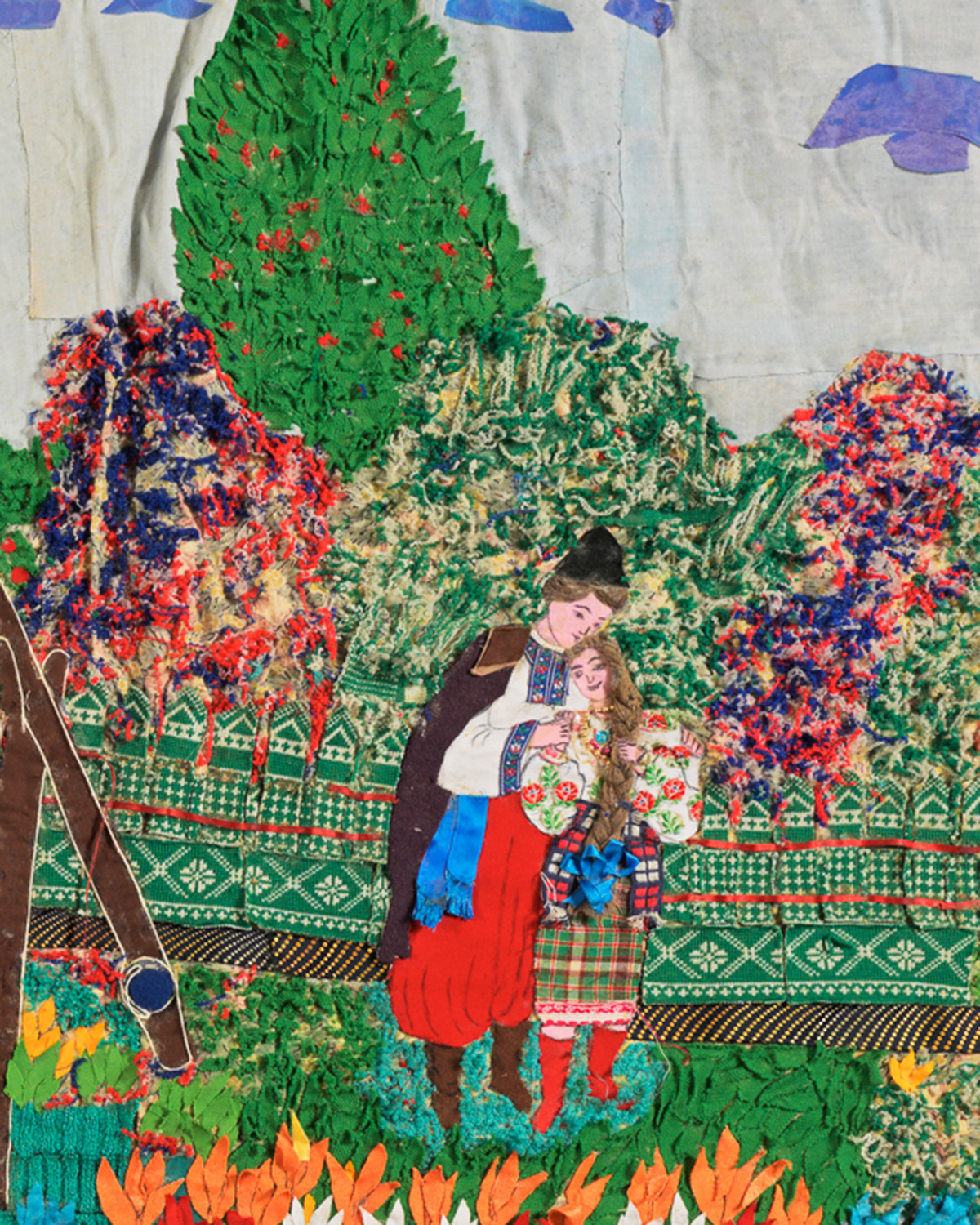

'Nativity Scene in The Village '
appliqué, fabric, marker 124×73×1cm
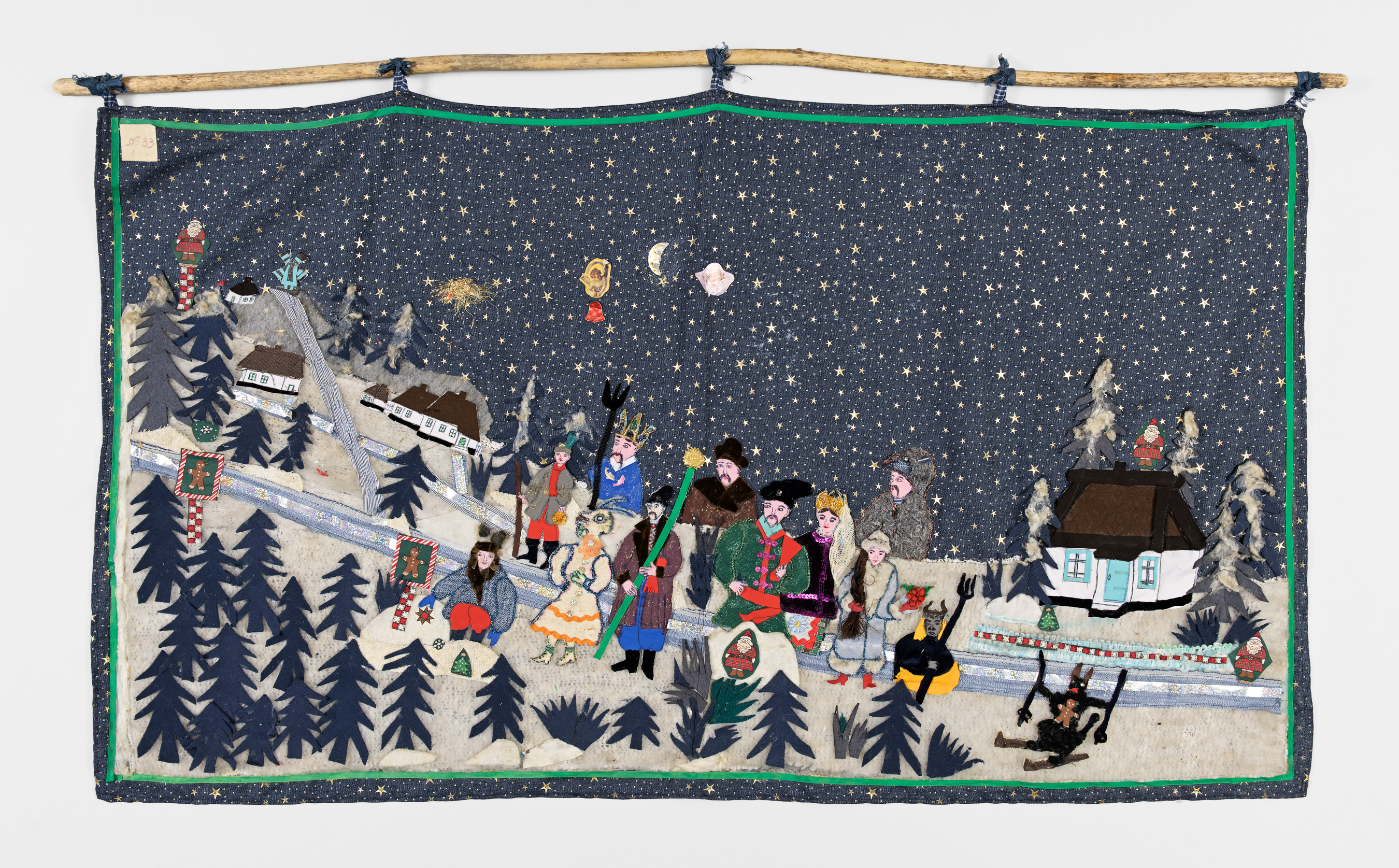
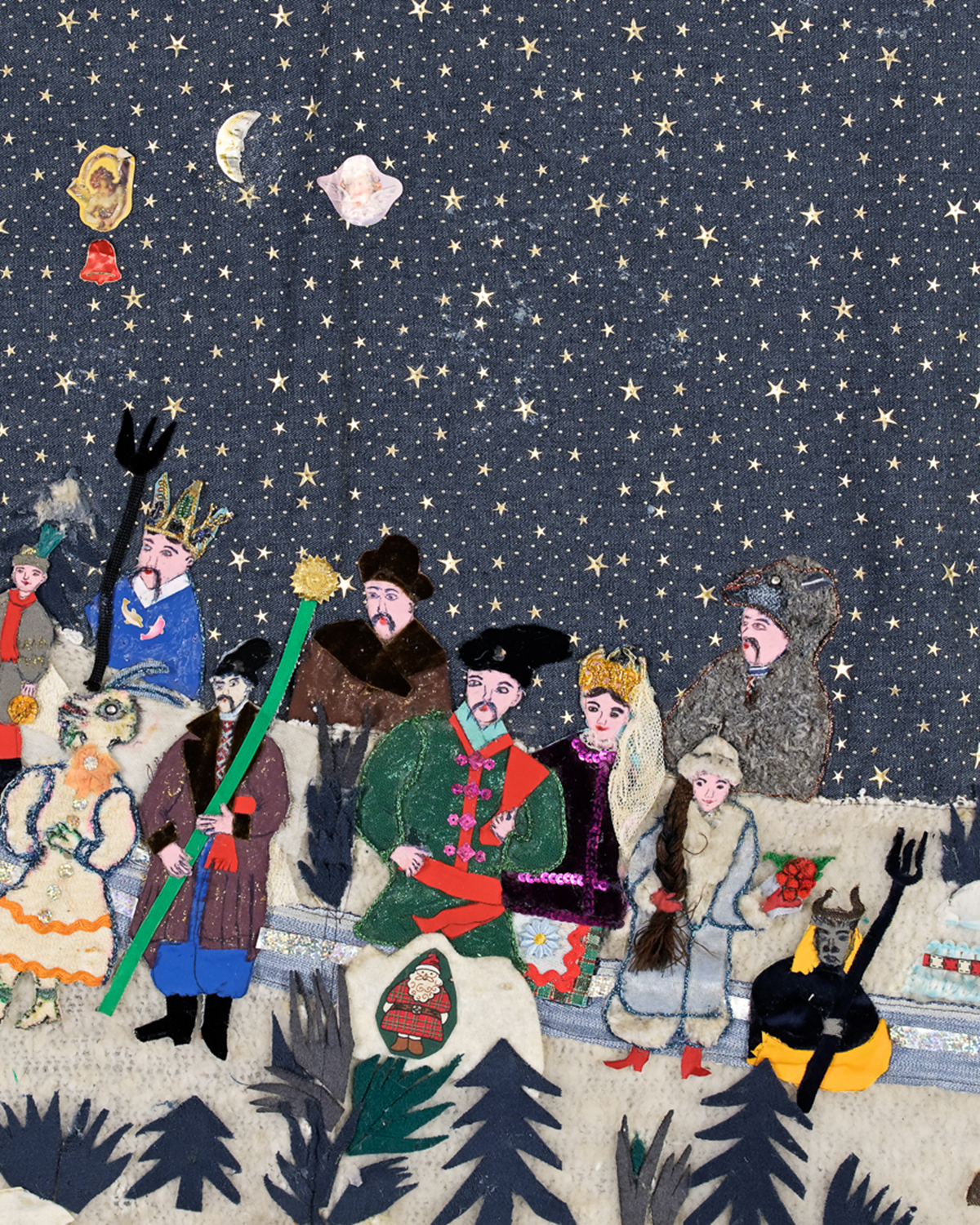

'Shevchenko in a Cap'
appliqué, fabric, marker 123×49×1cm
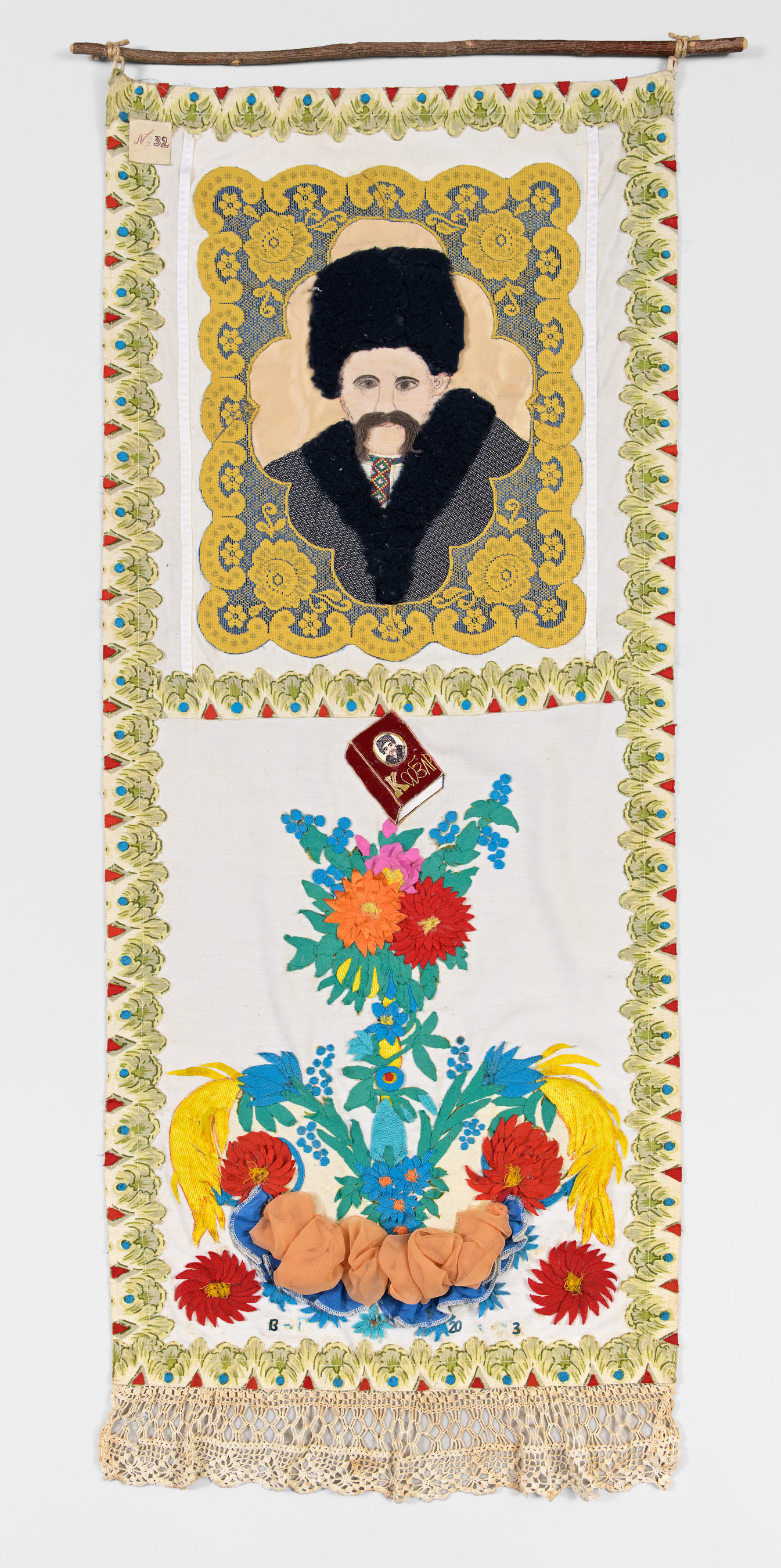


'Welcome'
appliqué, fabric, marker, framed 79×100×1cm
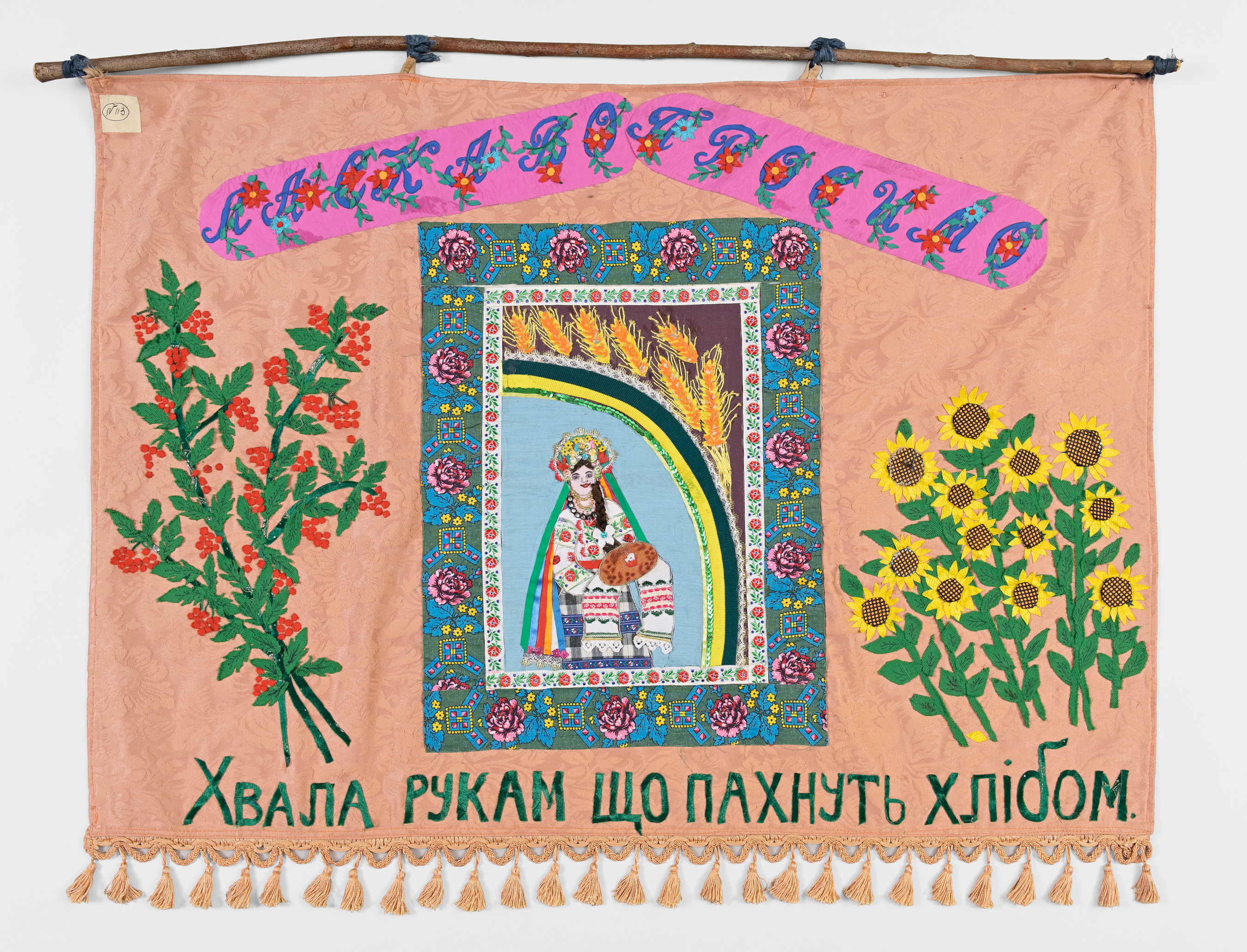
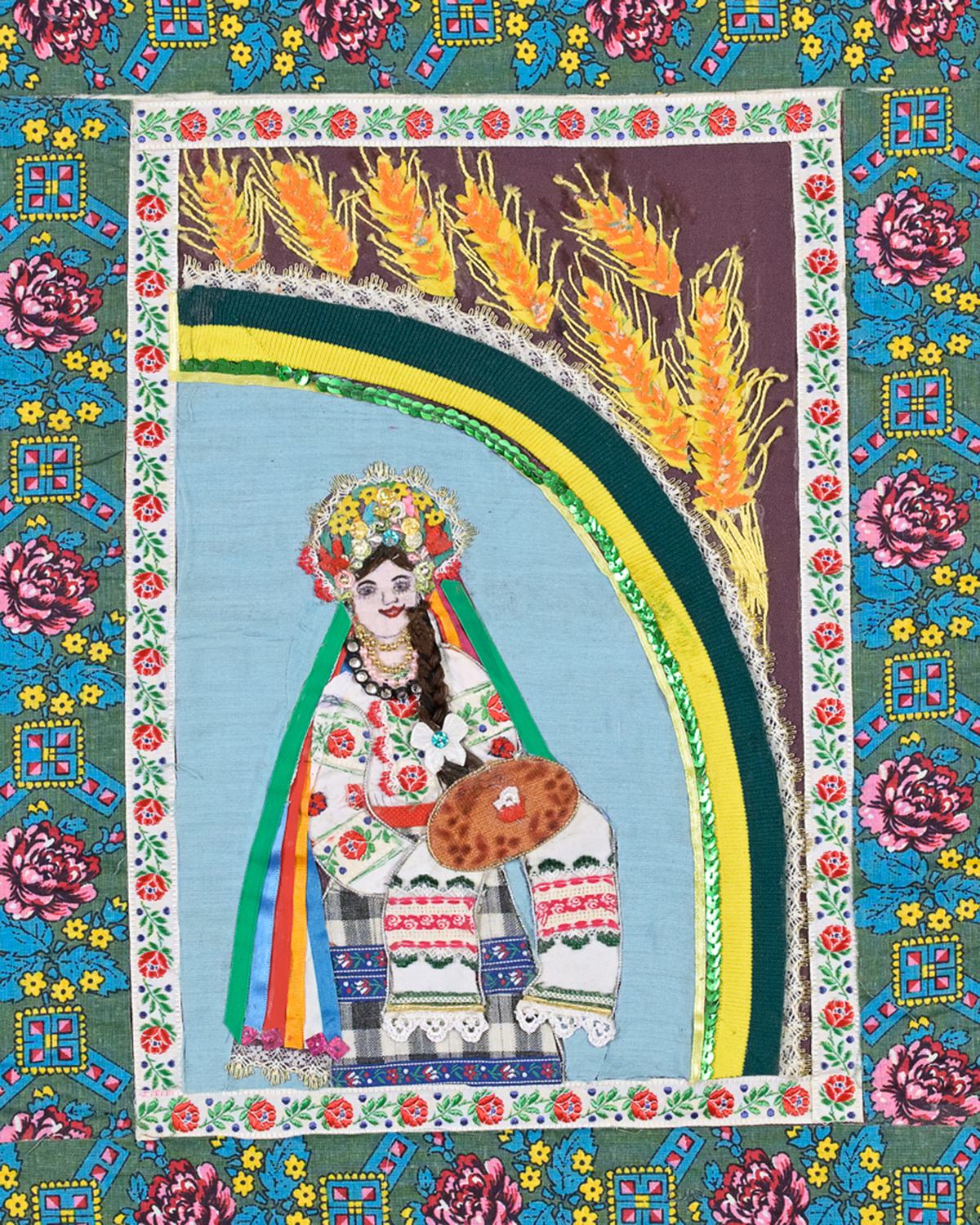

'Initials Vynnyk Nina Petrovna'
appliqué, fabric, marker 33×90×1cm
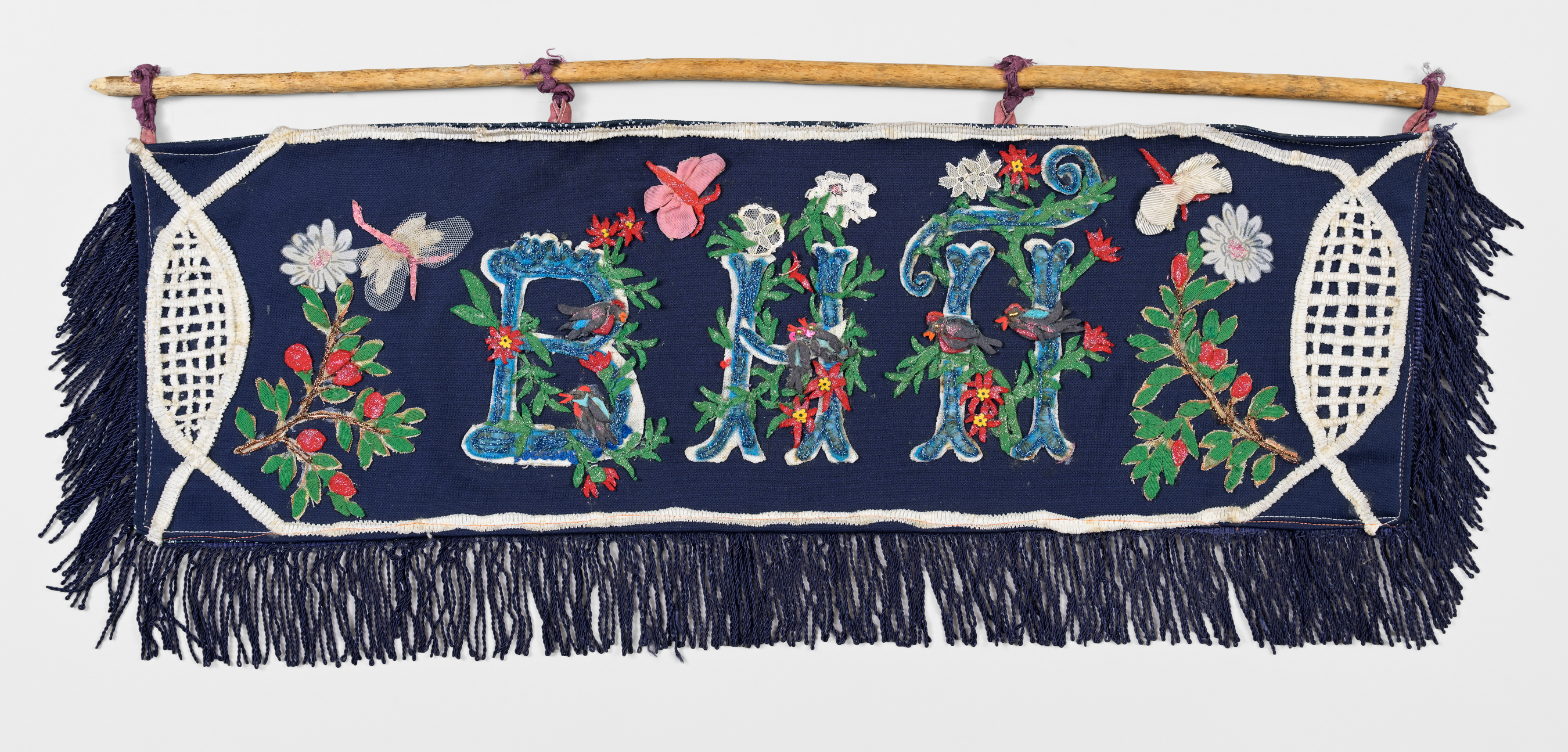


'Ukraine (Floral Inscription)'
appliqué, fabric, marker 20×91×1cm
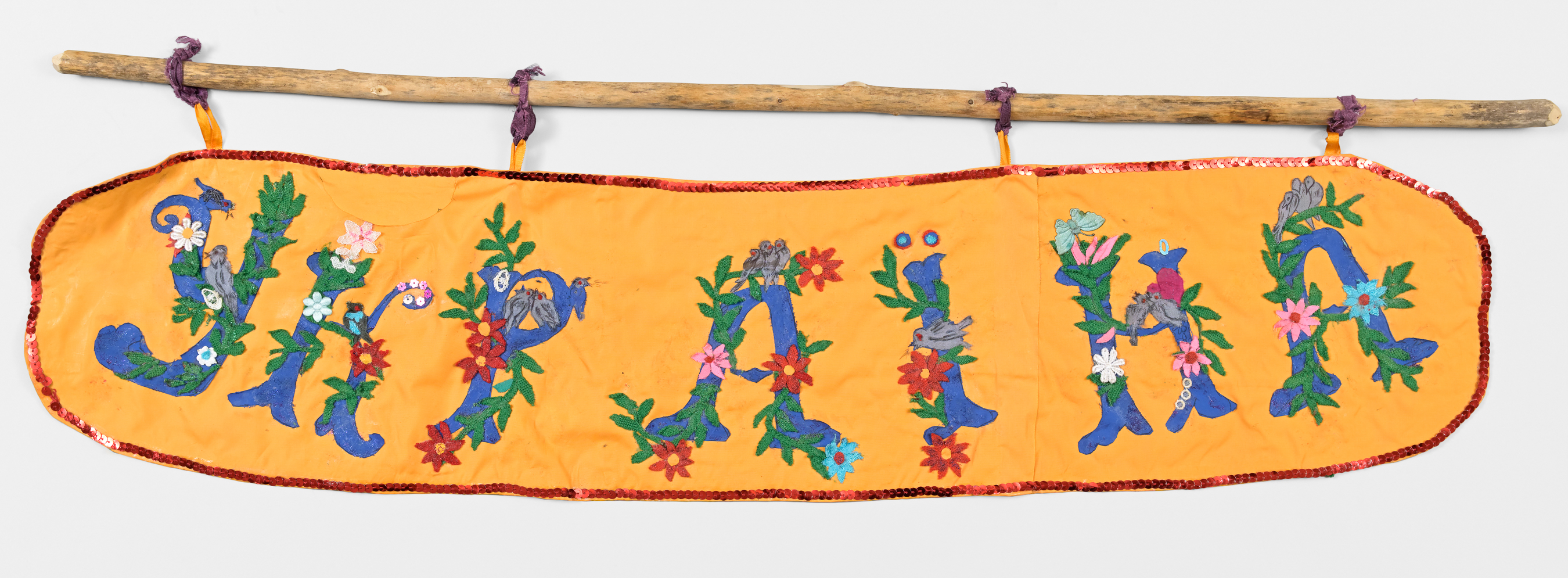
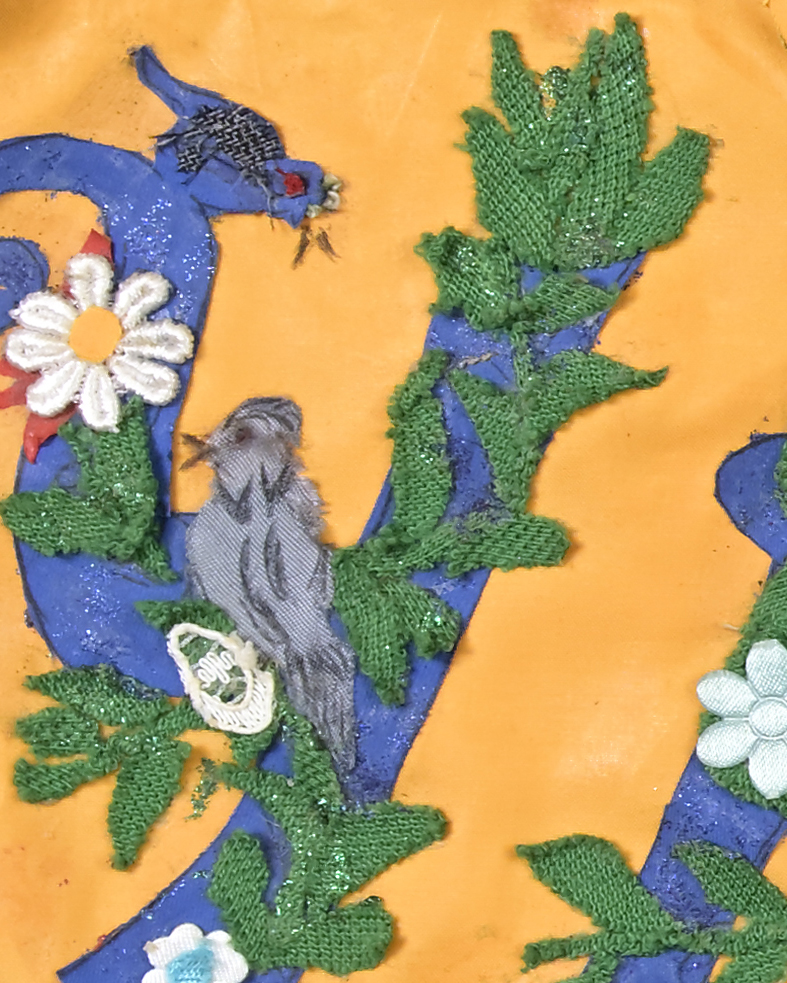

'Grandma with Chicken'
appliqué, fabric, marker 55×43×1cm
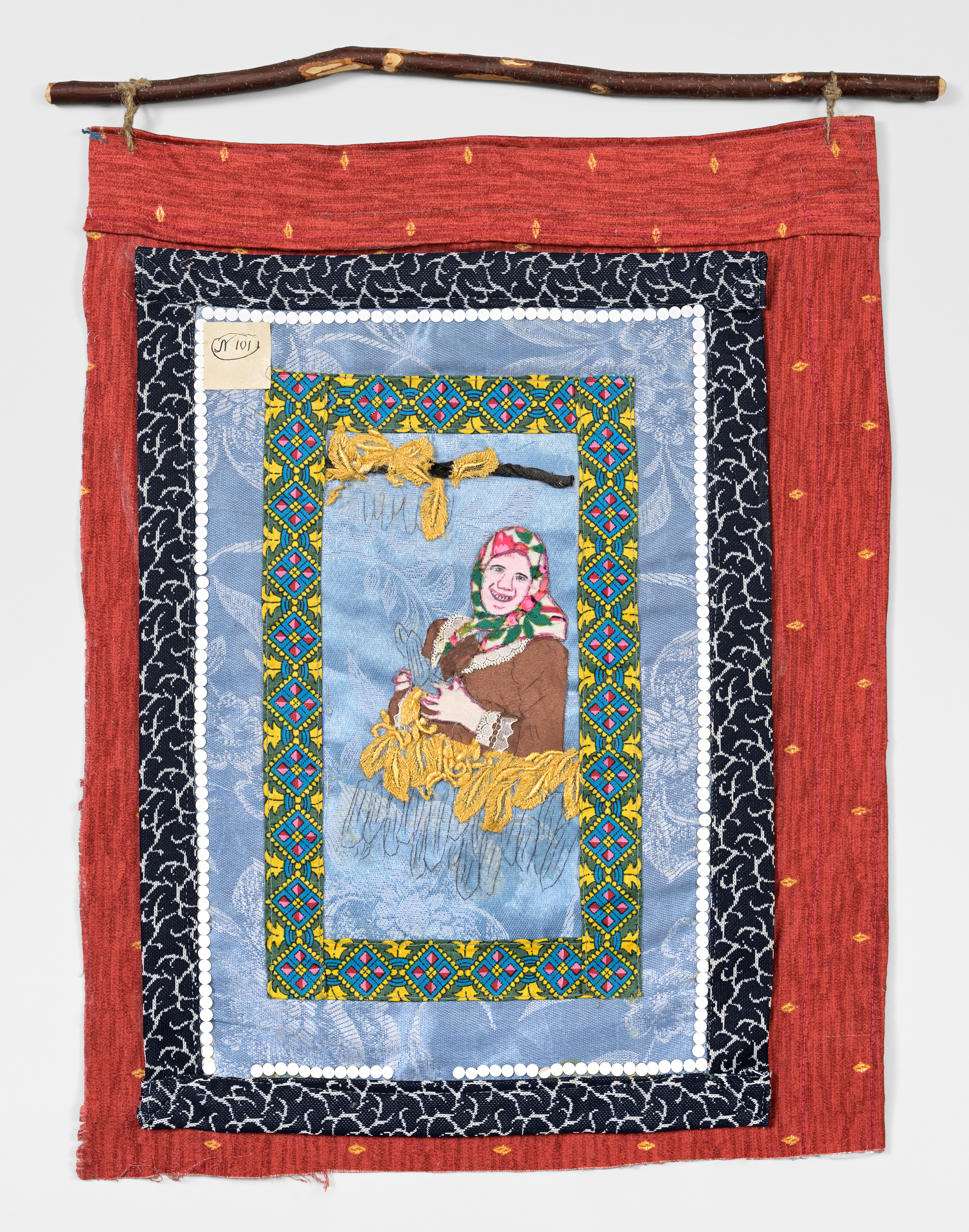
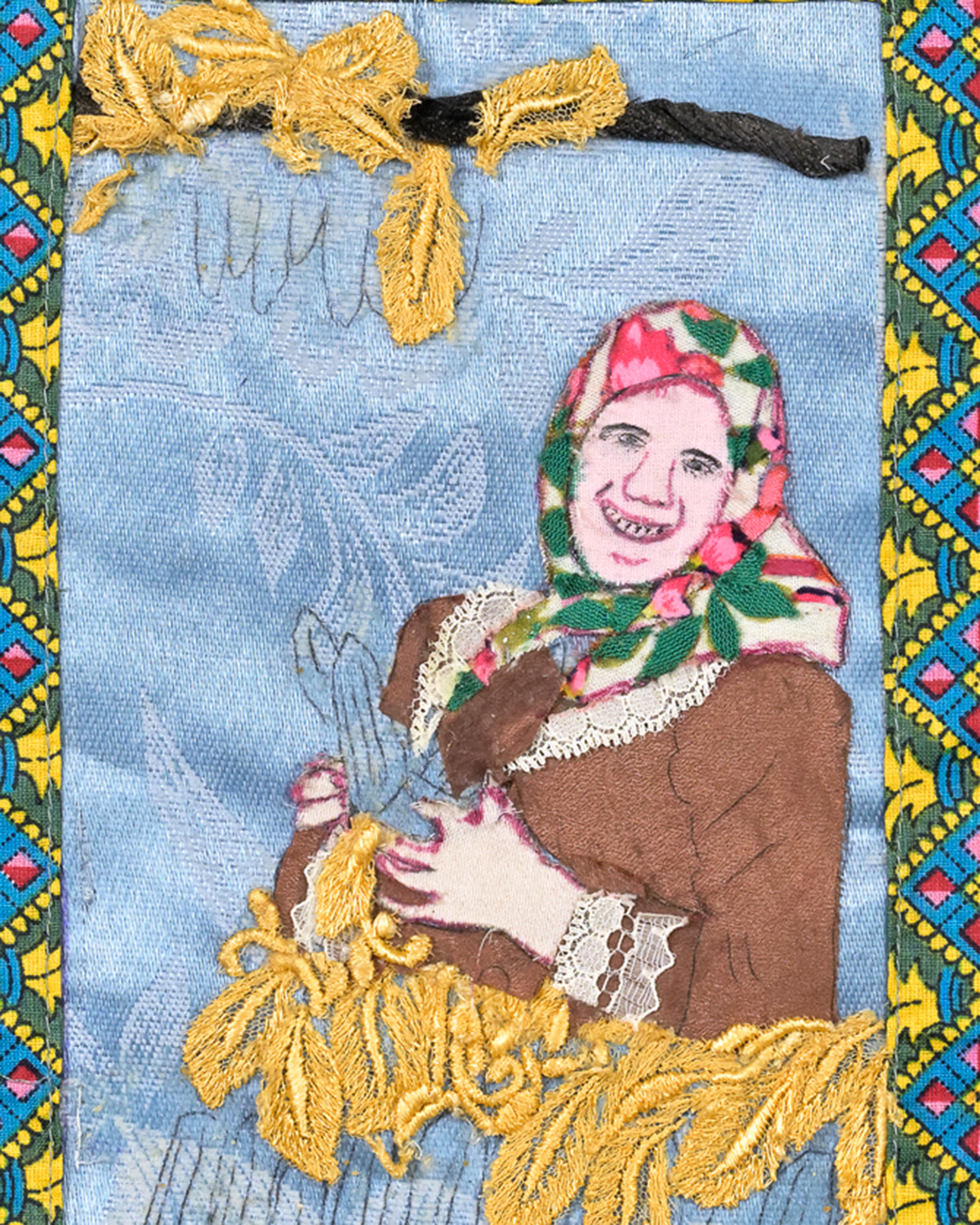

'Visiting Grandma V (Portrait with a Wreath)'
appliqué, fabric, marker 45×32×1cm
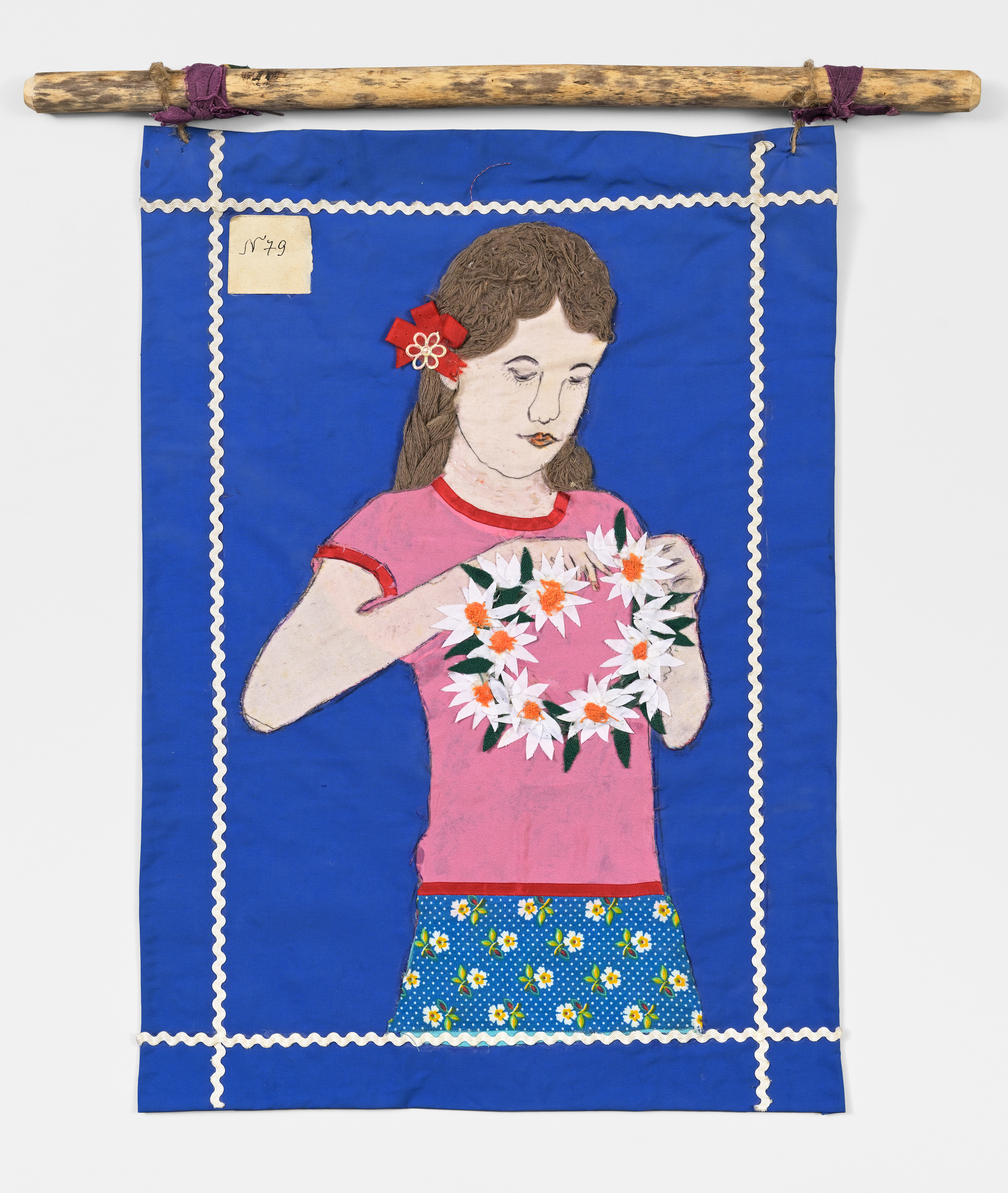
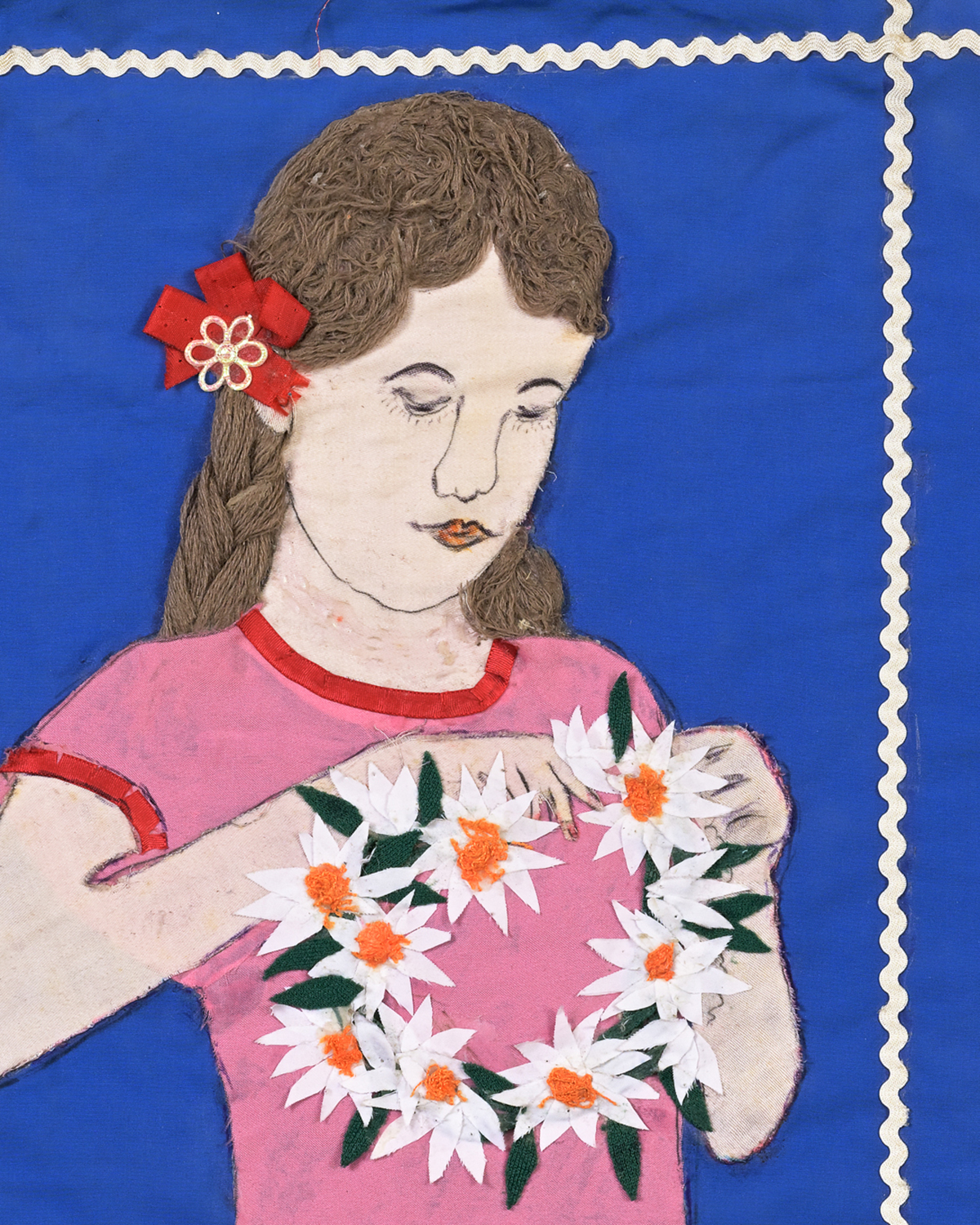

'Visiting Grandma VIII (Bathing with a Chicken) '
appliqué, fabric, marker 27×39×1cm
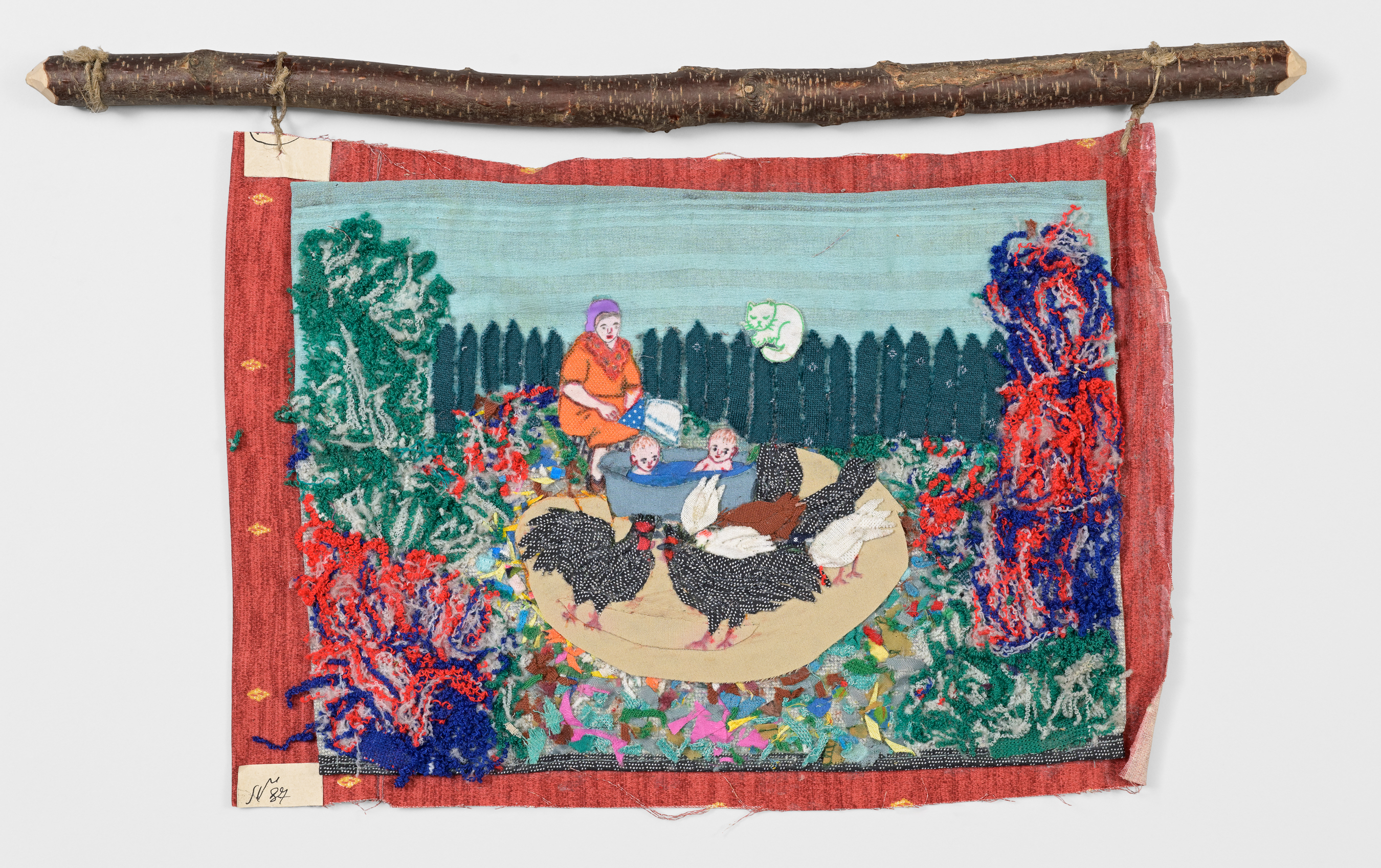
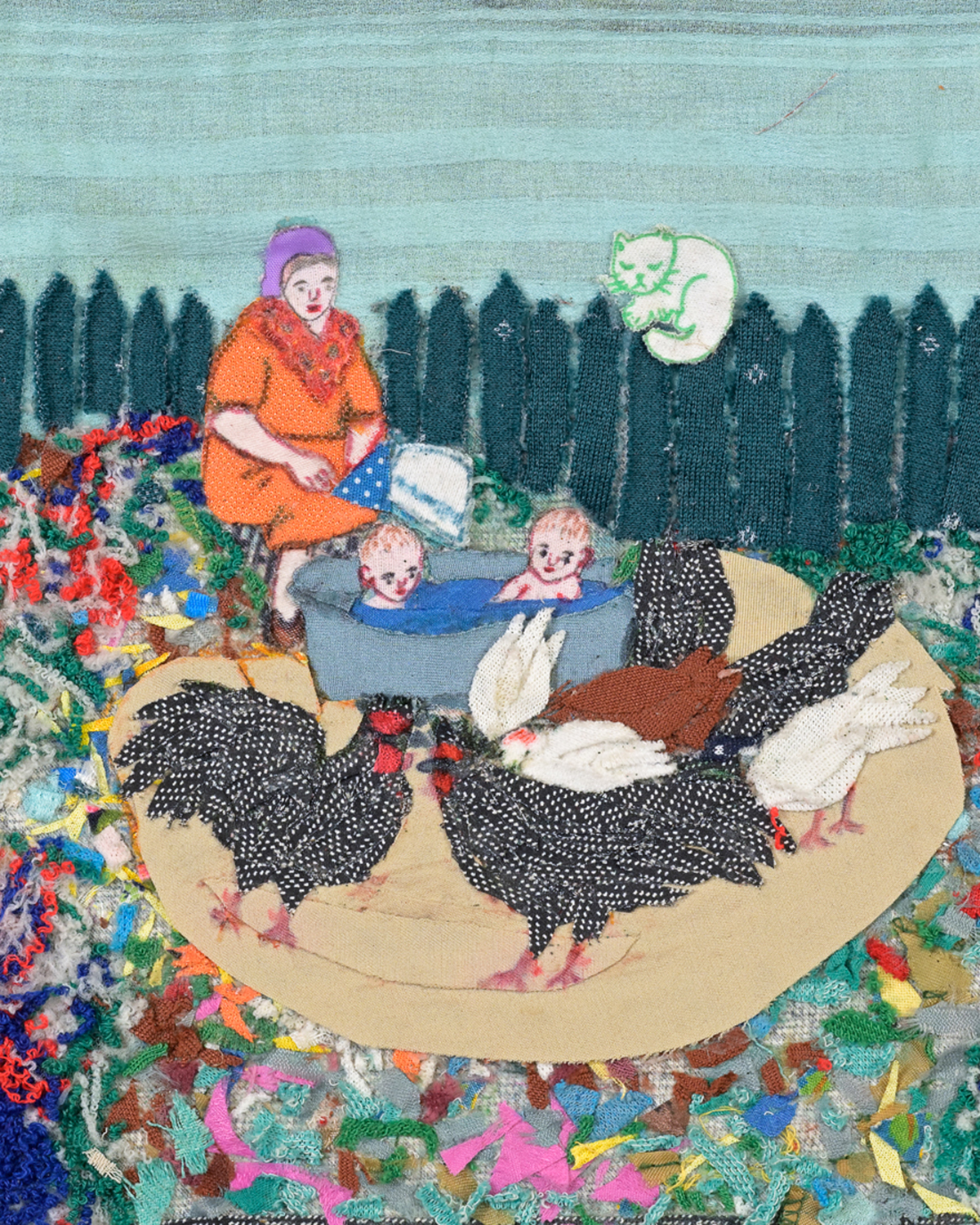
installation views
View: ,Created using the appliqué technique, Ukrainian Nina Vynnyk’s (1928–2011) pictures – wall-mounted and collected in albums – were born from homesickness. They tell of an ideal world to which evil has no access and life’s everyday difficulties and deep worries are replaced by affirmations and joy. An illusory paradise-like world reveals itself in Vynnyk’s works with the simplicity, sincerity, intimacy and bright colours typical of naïve art.
Ukrainian naïve art is characterised by its bright colours. Its roots go back to the 18th century, and it is strongly influenced by Ukrainian folk art, encompassing embroidery, decorated ceramics and woodcarving, murals on the walls of houses and decorations on everyday household items, as well as icon painting, including on glass.
Leading Ukrainian naïve artist Maria Prymachenko’s (1909–1997) decorative work and its clear outlines probably need no introduction as they have become a cultural emblem and a symbol of hope and peace for her war-torn country. Hanna Sobachko-Shostak (1883–1965), another central figure in Ukrainian naive art, employed intense and vibrant colours to create decorative paintings with dynamic compositions featuring plant and animal motifs. Her work was exhibited in her own lifetime in major cities around the world, including New York, Moscow, Berlin and Paris. Kateryna Bilokur (1900– 1961), who became an artist despite an array of obstacles, won the people’s adoration with her lush flower paintings. Bilokur’s paintings were also exhibited in her lifetime, with her greatest success coming in Paris in 1954 at an exhibition introducing Soviet art.
Born in the same year as Nina Vynnyk, Polina Rayko (1928–2004) redesigned her living environment, starting by painting the interior of an empty house after losing her husband and daughter. Like many naive artists, Rayko, who did not have an art education, devoted herself to art in her retirement, at first in secret, and driven by an inner compulsion to stave off loneliness. The figurative language of Rayko’s paintings included Christian, Soviet-era and pagan symbolism, depicting a mix of people close to her, domestic and exotic animals, nature, and various decorative motifs she found on household packaging – though, generally, these all “came” to her in her dreams. The cruelty of the current war is manifested everywhere, and sadly this outstandingly original part of Ukrainian cultural heritage has not remained untouched. The flood in June 2023 caused by the bursting of the dam of the Kakhovka hydroelectric power station also engulfed Rayko’s house, destroying most of the murals as it did so.
Hopefully, another gem will escape destruction, a surreal initiative the likes of which cannot be found anywhere else in the world: Kyiv pensioner Vladimir Chaika’s (1951) decoration of the dreary staircase in his suburban prefabricated building with baroque stucco decor, gold and opulent murals.
Nina Vynnyk’s work can be boldly placed among these unique greats. Having moved to Estonia from her homeland at the age of 70 to live with her eldest son, Vynnyk took advantage of the Ukrainian Cultural Centre to begin creating unique narrative pictures in appliqué from textile scraps such as pieces of wool and cotton cloth, lace, fur, feathers and braids. Previously, the difficulties of her everyday work and the need to feed the family had consumed most of her time. However, her inner drive to create found an outlet in home design, including decorating her rooms in Ukraine from floor to ceiling, leading to her neighbours’ pronouncement: “Your home is like a church”. While abroad, Vynnyk’s creative drive took on a different complexion. Born from the need to record her personal story for future generations, she began to create textile appliqués fastened to a dense synthetic fabric with buttons and bound together in gigantic photo albums and wall-mounted pictures.
Nina Vynnyk was born in 1928 in Dnipropetrovsk Oblast and lived a difficult life. Her mother died when she was five years old. And when her father was mobilised by the Soviet army and sent to the front in 1941, her stepmother threw Nina out of the house. In late autumn of the same year, 13-year-old Nina was taken to Germany, where she worked for three years, sharing a similar fate to many children taken from Ukraine and Belarus. In 1945, Nina was in Silesia, and when the Russian front reached the Silesian territories, though she was not even 17 years old, she was recruited into the so-called labour battalion. Those who had worked for the Germans – and therefore seen as disloyal by the Soviets – were formed into a construction force and marched to Berlin on foot. When the war ended, Nina did not manage to return home right away but instead worked on the construction of bridges on the Danube River. In Komárno, Czechoslovakia (now Slovakia), she completed her driving course and drove home across the Carpathians. She found a desolate and empty land upon her return. Famine was everywhere. Her home no longer existed. Yet, miraculously, she survived. Having settled in the area of her birth, she was employed by the sovkhoz, completing courses as a tractor driver and staying there for 52 years. During this period, things started looking up; she married, they built a house together, had children and cultivated their large vegetable garden. But once again, Vynnyk was dealt a fateful blow, as both her husband and younger son died unexpectedly. Her eldest son, living in Estonia, convinced her to come and join him. Nina sold her home in Ukraine and moved to Estonia. As she herself said: “I found myself in a new country, in the midst of a new way of life and new colours”. All alone, she began to reminisce, troubled by heavy thoughts. The personal mixed with the national and the national with the personal, turning into scenes from the paradise garden of one Ukrainian woman and the whole nation, where bright blue rivers shimmer under the rays of the sun, greenery flourishes, morning dew covers the ground, animals graze in the meadow, white houses are immersed in lush gardens, flocks of birds fly in the sky, colourful roosters amble, a pair of storks busy with their nest and a young woman sets off to milk the cow, the children close on her heels. The artist’s initials underneath the compositions – BHП (Vynnyk Nina Petrovna) – stand out beautifully in appliqué. It is possible that Nina Vinnik’s art would not have taken this form had she remained in Ukraine. Just as Estonians might have missed out on the rare paintings of centuries of Kihnu history had it not been for one of Estonia’s best-known naive artists, Jaan Oad (1899–1984) – who painted with great devotion after his retirement while living in exile in Canada. Or on the work of one of the most famous Ukrainian naïve artists living abroad, Dmytro Stryjek(1899–1991; also considered one of the most prominent Canadian naïve artists), parts of which depict what he had seen and experienced in Ukraine in his youth, portraits of Ukrainians and the historical events of his native land. Whether from the point of view of the viewer or the creator, naïve art plays the simple but important role of making connections visible, of comforting and of bringing joy.
The exhibition consists of 19 wall appliqués and 7 books with the author's personal appliqué technique.
Text: Mari Vallikivi
Exhibition is supported by The Cultural Endowment of Estonia and Punch Drinks.
Thank you: Anatoli Ljutjuk and the Ukrainian Cultural Centre, Mari Vallikivi and Kondas Centre, Olha Striutska, Katja Novak, Ukrainian folklore ensamble Zurba.
EST:
70-aastaselt kodumaalt oma vanema poja juurde Eestisse kolinud, alustas Nina Võnnõk (1928–2011) mõned aastad hiljem Ukraina Kultuurikeskuses tekstiilijääkidest nagu villa- ja puuvillariide tükid, pitsid, karusnahatükid, suled, palmikud (kõigest, mis kodus leidus) omapäraste aplikatsioonitehnikas jutustavate piltide loomist, mis sündisid vajadusest talletada järeltulevale põlvkonnale oma isiklik, aga ka Ukraina lugu. Nina Võnnõku seina-ja albumipildid jutustavad ideaalsest maailmast, kuhu kurjusel puudub ligipääs, igapäevased eluraskused ja murede sügavus asendatakse elujaatuse ja rõõmuga. Illusoorne paradiisiaia-sarnane maailm ilmutab end Võnnõku töödes naivistlikule kunstile omaselt lihtsalt, siiralt, intiimsete detailide ja erksa värvipaletiga.
Näitusel eksponeeritakse 19 seinaaplikatsiooni ja 7 aplikatsioonitehnikas autoriraamatut.
Tekst: Mari Vallikivi
Näitust toetavad: Eesti Kultuurikapital ja Punch drinks.
Tänud: Anatoli Ljutjuk ja Ukraina Kultuurikeskus, Mari Vallikivi, Kondase keskus, Olha Striutska, Katja Novak ja Ukraina folklooriansambel „Žurba”.
